ADC Telecommunications PSM0804A FlexWave™ Prism - Cellular 40 Watt User Manual 1
ADC Telecommunications Inc FlexWave™ Prism - Cellular 40 Watt Users Manual 1
Contents
- 1. Users Manual 1
- 2. Users Manual 2
- 3. Users Manual 3
- 4. Users Manual 4
Users Manual 1
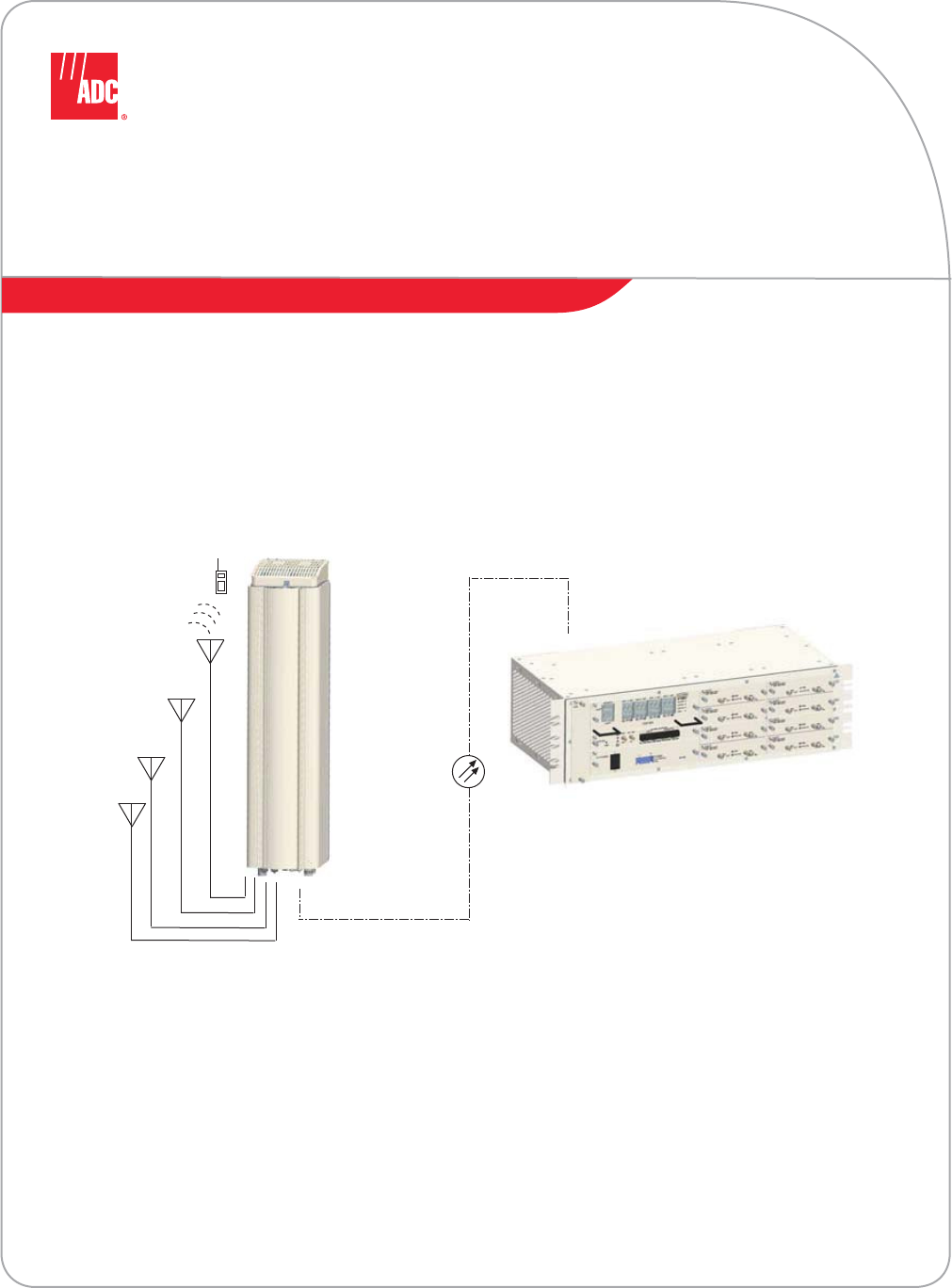
ADC FlexWave® Prism
Element Management System 7.1
User Manual
D-620749-0-20 Rev A
Antenna
Antenna
Antenna
Quad Band
Remote Unit
Host Unit
Antenna
77073-001
ADCP-77-177 Issue 1 July 2011
Copyright
© 20 11 ADC Telecommun ications, Inc. All Rights Reserved.
Inform ation contained in this document is company private to ADC Telecommunications, Inc. and shall not
be modified, used, copied, reproduced or disclosed in whole or in part without the written consent of ADC.
Trade m ark I nform ation
ADC and FlexWave are registered tradem arks, and InterReach Spectrum and Universal Radio Head are
trademarks of ADC Telecommunications, Inc. No right, license, or interest to such trademarks is granted
hereunder, and you agree that no such right, license, or interest shall be asserted by you with respect to such
trademark.
Other product names mentioned in this practice are used for identification purposes only and may be
trademarks or registered tradem arks of their respective companies.
Disclaim e r of Lia bilit y
Con t en t s h er ein ar e cu r r en t as of th e d a t e of pu blica t io n . ADC reserves the right to change the contents without
prior notice. Should the content of prin ted user documentation shipped with product differ from
documentation provided on a product CD (inclusive of the associated Help modules), the printed user
documentation supersedes the documentation on the product CD. In no event shall ADC be liable for any
damages resulting from loss of data, loss of use, or loss of profits, and ADC further disclaims any and all liability
for indirect, in cidental, special, consequential or other similar damages. This disclaim er of liability applies to
all products, publications and services during and after the warranty period.
Specific Disclaim e r for High- Risk Act ivities
This Software Product is not specifically designed, manufactured, tested or intended for use in high-risk
activities including, without restricting the gen erality of the foregoing, on-line control of aircraft, air traffic,
aircraft navigation or aircraft commun ications; or in the design, construction, operation or maintenance of any
nuclear facility. ADC (including its affiliates) and its suppliers specifically disclaim an y express or im plied
warranty of fitn ess for such purposes or any other purposes.
Screenshot s in User Docum enta t ion
Due to concurrent development of this documentation, artwork, and the FlexWave Prism EMS product, there
may be som e minor discrepancies between screenshots contained in this documentation and those actually
displayed in the FlexWave Prism EMS. These discrepancies will generally be few and minor and should not
affect your understanding of FlexWave Prism EMS.

FlexWave Prism Elem ent Managem ent System 7.1 User Manual Page iii
ADCP- 77- 1 77 • I ssue 1 • July 2011 © 2011 ADC Telecommunications, Inc.
TABLE OF CONTENTS
Pr efa ce _ _ _ _ _ _ _ _ _ _ _ _ _ _ _ _ _ _ _ _ _ _ _ _ _ _ _ _ _ _ _ _ _ _ _ _ _ _ _ _ _ _ _ _ _ _ _ _ _ _ _ _ _ _ _ _ _ _ ix
FlexWave Prism User Docum entation ......................................................................................... x
EMS Docum ent Overview ......................................................................................................... xi
Docum ent Cautions and Not es............................................................................................. xi
Docum ent Fonts ................................................................................................................ xi
Docum ent Fonts ................................................................................................................ xi
Docum ent Graphics .......................................................................................................... xii
Abbreviat ions/ Acronym s ....... ................. ........ ........ ........ ........ ........ ... ...... .......... ........ ............. xiii
Pa r t I : Flex W ave Pr ism Hardw a r e _ _ _ _ _ _ _ _ _ _ _ _ _ _ _ _ _ _ _ _ _ _ _ _ _ _ _ _ _ _ _ 1
Pr ism Syst e m Over vie w _ _ _ _ _ _ _ _ _ _ _ _ _ _ _ _ _ _ _ _ _ _ _ _ _ _ _ _ _ _ _ _ _ _ _ _ _ _ _ _ _ _ _ _ _ 3
Prism System Overview ...........................................................................................................4
Fiber Opt ic Transport ..............................................................................................................10
Host Unit Overview ................................................................................................................11
Fan Module......................................................................................................................11
SeRF I I Module ................................................................................................................12
SeRF I I Module Ports ...................................................................................................12
SeRF I I Module LEDs ................................................................................................... 13
Host System I I Module ......................................................................................................14
Host Syst em I I Module Ports and Connectors ..................................................................14
Host System I I Module LEDs.........................................................................................15
DC Power Module ............................................................................................................. 15
Prism Remot e Units................................................................................................................16
PRU Ports and Connectors ( Bot t om of PRU) .......................................................................... 17
PRU Status LED ( Bottom of PRU) ........................................................................................18
PRU Com ponents.............................................................................................................. 19
RF Module Capabilit ies and GUI Represent ation ....................................................................21
DART Modules .......................................................................................................................24
Host DARTs .....................................................................................................................26
Host DART Slot s .........................................................................................................27
Host DART Connect ors and LEDs ...................................................................................28
Serialized RF (SeRF) Digit al Prot ocol ...................................................................................29
Sim ulcast Groups ............................................................................................................. 30
Use of Mult i Fibers ............................................................................................................31
E911 Support ...................................................................................................................32
Prism System Specifications ....................................................................................................33

Table of Content s
Page iv Flex Wave Prism Elem ent Managem ent Syst em 7.1 User Manual
© 2011 ADC Telecommunications, Inc ADCP-77-177 • I ssue 1 • July 2011
Pa r t I I : Syst e m Set up _ _ _ _ _ _ _ _ _ _ _ _ _ _ _ _ _ _ _ _ _ _ _ _ _ _ _ _ _ _ _ _ _ _ _ _ _ _ 3 7
Using t he Prism EMS _ _ _ _ _ _ _ _ _ _ _ _ _ _ _ _ _ _ _ _ _ _ _ _ _ _ _ _ _ _ _ _ _ _ _ _ _ _ _ _ _ _ _ _ _ _ _ 3 9
How t o Use the EMS Graphical User I nterface ............................................................................40
Syst em Tree ....................................................................................................................41
Syst em Tree I cons............................................................................................................42
EMS View Fram e Elem ent s................................................................................................. 42
Unit I dentification .............................................................................................................43
Viewing Param eters and Alarm s .........................................................................................44
Alarm Color Codes ...................................................................................................... 44
Viewing Alarm Details..................................................................................................45
Sorting Tables..................................................................................................................46
Following t he Procedures in t his Docum ent ................................................................................47
St arting a Procedure .........................................................................................................47
Modifying Param eters........................................................................................................ 47
Selecting Menu I tem s........................................................................................................ 48
Using t he Help Em bedded in t he GUI ........................................................................................49
Accessing Help .................................................................................................................49
Navigating Help................................................................................................................50
Using t he Cont ent s Tab................................................................................................50
Using t he Orientation Links and Butt ons......................................................................... 51
Using t he I ndex Tab ....................................................................................................52
Using t he Search Tab ..................................................................................................53
I nit ia l Flex W a ve Prism Syst em Se tu p _ _ _ _ _ _ _ _ _ _ _ _ _ _ _ _ _ _ _ _ _ _ _ _ _ _ _ _ _ _ _ _ _ _ 5 5
Minim um EMS Syst em Requirem ents ........................................................................................ 56
Access the EMS ..................................................................................................................... 57
Set Session Tim eout ...............................................................................................................59
Set Dat e and Tim e ................................................................................................................. 60
Set Network Connect ions ........................................................................................................63
Configure Basic Host Unit Properties ......................................................................................... 64
Label the PRU/ URU................................................................................................................. 66
Label the Host Opt ical Port s..................................................................................................... 67
Label PRU/ URU Opt ical Port s ................................................................................................... 70
Configure DART Links .............................................................................................................71
Classic DART Models ......................................................................................................... 75
800 APAC iDEN Classic DART ........................................................................................75
800 SMR Classic DART................................................................................................. 75
900 SMR Classic ......................................................................................................... 76
2100 AWS Classic DART...............................................................................................76
Cellular Classic DART...................................................................................................77
PCS Classic DART........................................................................................................77
SuperDART Models ........................................................................................................... 79
700 Lower ABC SuperDART .......................................................................................... 79
700 UpperC SuperDART ...............................................................................................79
2100 AWS SuperDART .................................................................................................79
EGSM 900 Super DART ................................................................................................. 79
GSM 1800 SuperDART ................................................................................................. 80
PCS SuperDART..........................................................................................................80
UMTS SuperDART .......................................................................................................80
DART St art and St op Frequencies .......................................................................................81
Set t he Forward and Reverse Delays......................................................................................... 82
Using t he Linked DARTs Delay Table ...................................................................................83
Filtering t he Linked DARTs Delay Table................................................................................84
Configure Host Forward Gain ...................................................................................................85
Configure Host Reverse Gain ...................................................................................................88
Configure Rem ot e Forward Gain ...............................................................................................91
Configure Reverse I nput Power Levels ...................................................................................... 94

Table of Contents
FlexWave Prism Elem ent Managem ent System 7.1 User Manual Page v
ADCP- 77- 1 77 • I ssue 1 • July 2011 © 2011 ADC Telecom m unications, I nc.
Pa r t I I I : Syst em Ma n agement ________________________________ 97
Syste m I nform a t ion _ _ _ _ _ _ _ _ _ _ _ _ _ _ _ _ _ _ _ _ _ _ _ _ _ _ _ _ _ _ _ _ _ _ _ _ _ _ _ _ _ _ _ _ _ _ _ 9 9
Get I nform at ion ................................................................................................................... 100
Accessing System Report s ............................................................................................... 101
Viewing t he Software/ Firm ware Report ........................................................................ 101
Viewing t he Hardware I nventory Report ....................................................................... 102
Viewing t he Net work Report ....................................................................................... 104
Viewing t he Linked DARTs Report ................................................................................ 105
Viewing t he Delay Report ........................................................................................... 106
Viewing t he Fiber Report ............................................................................................ 107
Viewing t he Host RF Report ........................................................................................ 108
Viewing t he Rem ot e RF Report .................................................................................... 109
Viewing t he Alarm s Report ......................................................................................... 110
I FEU + RAU Report ................................................................................................... 111
Viewing t he All Report ............................................................................................... 112
Downloading a Report ..................................................................................................... 113
Get Opt ics I nformation ......................................................................................................... 116
Get Logs ............................................................................................................................. 118
Syste m M a nage m e nt _ _ _ _ _ _ _ _ _ _ _ _ _ _ _ _ _ _ _ _ _ _ _ _ _ _ _ _ _ _ _ _ _ _ _ _ _ _ _ _ _ _ _ _ _ 1 2 1
Moving or Reconfiguring Fibers .............................................................................................. 122
Edit the Propert ies of All Units in t he System ........................................................................... 123
Reset All Units to Factory Default ........................................................................................... 124
Backing Up a Syst em Configuration ........................................................................................ 126
Restoring a Backed Up System Configurat ion ........................................................................... 128
Perform Syst em Test ............................................................................................................ 131
Schedule Syst em Test .......................................................................................................... 135
Schedule Syst em Tests by Date and Tim e .......................................................................... 135
Disable a Scheduled System Test...................................................................................... 137
Set SNMP Trap Managers ...................................................................................................... 138
Adding an SNMP Trap Manager ......................................................................................... 139
Modifying an SNMP Trap Manager ..................................................................................... 141
Delet ing an SNMP Tr ap Manager ....................................................................................... 142
Setup SNMP ....................................................................................................................... 144
Activat e Optional Features .................................................................................................... 145
Ma na ging Unit s_ _ _ _ _ _ _ _ _ _ _ _ _ _ _ _ _ _ _ _ _ _ _ _ _ _ _ _ _ _ _ _ _ _ _ _ _ _ _ _ _ _ _ _ _ _ _ _ _ _ 1 4 7
Basic Unit Views .................................................................................................................. 148
View Opt ical Port s ................................................................................................................ 149
Viewing DARTs .................................................................................................................... 151
Viewing Net work Statist ics .................................................................................................... 152
Editing Unit Properties .......................................................................................................... 153
Configuring Opt ical Ports.......................................................................................................153
Viewing t he St atus of the Host Unit ........................................................................................ 154
Viewing t he St atus of a Remot e Unit ....................................................................................... 156
Module Status Table ....................................................................................................... 156
DART Stat us Table .................................................................................................... 157
LNA St at us Table ...................................................................................................... 158
LPA Status Table....................................................................................................... 158
PD Status Table ........................................................................................................ 159
Opt ical Status Table........................................................................................................ 159
Rem ote St atus Table....................................................................................................... 160
Rem ot e Unit Capacity and Temperature............................................................................. 160
Clearing DART Configurations ................................................................................................ 161
Set t he Capacity for a New Rem ot e Unit RSI Board ................................................................... 162
Using t he EMS GUI to Change the Remot e Unit Capacity ...................................................... 162
Using Telnet or ssh to Change the Rem ot e Unit Capacit y...................................................... 163
Rebooting a Unit .................................................................................................................. 164
Reset t ing an LPA.................................................................................................................. 165

Table of Content s
Page vi Flex Wave Prism Elem ent Managem ent System 7.1 User Manual
© 2011 ADC Telecommunications, Inc ADCP-77-177 • I ssue 1 • July 2011
Ala rm s _ _ _ _ _ _ _ _ _ _ _ _ _ _ _ _ _ _ _ _ _ _ _ _ _ _ _ _ _ _ _ _ _ _ _ _ _ _ _ _ _ _ _ _ _ _ _ _ _ _ _ _ _ _ _ _ 1 6 7
View Current Alarm s.............................................................................................................168
Clear Current Alarm s ............................................................................................................170
View Alarm History ............................................................................................................... 170
Clearing Alarm History ..........................................................................................................172
Filtering t he Alarm History .....................................................................................................172
Manage Alarm s.................................................................................................................... 174
Enable and Disable Host and Remot e Unit Alar m s ............................................................... 178
Set RF Power Low Threshold ............................................................................................ 180
Antenna Disconnect Alarm ............................................................................................... 181
Manage Cont act Alarm s ........................................................................................................ 182
Acknowledge All Alarm s ........................................................................................................ 183
Clear All Disconnect Alarm s ................................................................................................... 184
Troubleshoot ing Alarm s ........................................................................................................ 185
Major Alarm s—Host Unit .................................................................................................. 185
Major Alarm s—Host Unit DARTs........................................................................................ 185
Major Alarm s—Host SeRF Modules .................................................................................... 187
Major Alarm s—Host Unit SFPs .......................................................................................... 188
Major Alarm s—Remote Units ............................................................................................ 189
Major Alarm s—PRU/ URU DARTs........................................................................................ 189
Major Alarm s—PRU/ URU SeRF Modules.............................................................................. 191
Major Alarm s—PRU/ URU SFPs .......................................................................................... 193
Major Alarm s—PRU or URU Duplexer ................................................................................. 194
Major Alarm s—PRU or URU LNA........................................................................................ 194
Major Alarm s—PRU or URU LPA ........................................................................................ 195
Major Alarm s—PRU or URU Power Det ector ........................................................................ 196
Minor Alarm s—Host Unit DARTs........................................................................................ 197
Minor Alarm s—Host Unit SeRF Module ............................................................................... 197
Minor Alarm s—Host Unit SFPs .......................................................................................... 198
Minor Alarm s—PRU/ URU DARTs........................................................................................ 198
Minor Alarm s—PRU/ URU SeRF Modules.............................................................................. 199
Minor Alarm s—PRU/ URU SFPs .......................................................................................... 200
Minor Alarm s—PRU or URU LPAs....................................................................................... 200
Cont act Alarm s—Host System Card................................................................................... 201
Cont act Alarm s—Remote Unit .......................................................................................... 201
Users _ _ _ _ _ _ _ _ _ _ _ _ _ _ _ _ _ _ _ _ _ _ _ _ _ _ _ _ _ _ _ _ _ _ _ _ _ _ _ _ _ _ _ _ _ _ _ _ _ _ _ _ _ _ _ _ _ 2 0 3
Understanding FlexWave EMS User Account s ........................................................................... 204
Manage Users Page .............................................................................................................. 205
Add a New User ............................................................................................................. 205
Change a User’s Access Level ........................................................................................... 207
Change a User Password ................................................................................................. 208
Change Your Personal Password ............................................................................................. 210
Recovering a Password ......................................................................................................... 211
Delet e a User ...................................................................................................................... 212
Upgrading t he Syst e m and Units _ _ _ _ _ _ _ _ _ _ _ _ _ _ _ _ _ _ _ _ _ _ _ _ _ _ _ _ _ _ _ _ _ _ _ _ 2 1 3
Upload t he Upgrade Files ...................................................................................................... 214
Updat ing a Prism System ...................................................................................................... 216
Com m it t he Upgrade ............................................................................................................ 219
Abort an Updat e .................................................................................................................. 220
Updat ing I ndividual Units ...................................................................................................... 221
Special Fea t ure s _ _ _ _ _ _ _ _ _ _ _ _ _ _ _ _ _ _ _ _ _ _ _ _ _ _ _ _ _ _ _ _ _ _ _ _ _ _ _ _ _ _ _ _ _ _ _ _ _ 2 2 5
Run Script ........................................................................................................................... 226
Run Com m and .....................................................................................................................226
Configure Feat ure ................................................................................................................ 227

Table of Contents
FlexWave Prism Elem ent Managem ent System 7.1 User Manual Page vii
ADCP- 77- 1 77 • I ssue 1 • July 2011 © 2011 ADC Telecom m unications, I nc.
Using a n SN M P I nte rfa ce _ _ _ _ _ _ _ _ _ _ _ _ _ _ _ _ _ _ _ _ _ _ _ _ _ _ _ _ _ _ _ _ _ _ _ _ _ _ _ _ _ _ 2 2 9
SNMP Overview ...................................................................................................................230
Working with Prism MI B Files................................................................................................. 231
Accessing Prism MI Bs...................................................................................................... 233
Syst em Dat e and Time MI B Form at ................................................................................... 234
Band Types ................................................................................................................... 235
Prism MIB Obj ect s................................................................................................................ 236
Param et ers in ADC-FLEXWAVE- URH- MIB ........................................................................... 237
Syst em- Level Param eters .......................................................................................... 237
Host Unit Param et ers ................................................................................................ 239
Host Parameters.................................................................................................. 239
Host SeRF Card Param eters .................................................................................. 240
Host SeRF Optics Param eters ................................................................................ 243
Host SeRF ENET Switch Param eters ....................................................................... 245
Host SeRF FPGA Param et ers ................................................................................. 247
Host List of Rem ot es Param eters ........................................................................... 247
Host DART Module Param et ers .............................................................................. 248
Host Syst em Card Param eters ............................................................................... 252
Rem ote Unit Param et ers ............................................................................................ 254
Rem ote Param eters ............................................................................................. 254
Prism Remot e System Card................................................................................... 256
Prism Rem ot e SeRF General.................................................................................. 257
Prism Rem ot e SeRF Opt ics.................................................................................... 260
Prism Rem ot e SeRF ENET Switch ........................................................................... 262
Prism Rem ot e SeRF FPGA ..................................................................................... 264
Prism Rem ot e DART............................................................................................. 264
Prism Remot e LPA ............................................................................................... 270
Prism Rem ot e Power Det ect or ............................................................................... 272
Prism Remot e LNA/ Duplexer ................................................................................. 273
Prism Rem ot e RDI Card ........................................................................................ 274
Prism Rem ot e RSI Card ........................................................................................ 275
Com m on Managed Obj ect s ......................................................................................... 276
Prism DART Mapping ............................................................................................ 276
Schedule Syst em Link Test ................................................................................... 278
SNMP Sett ings .................................................................................................... 279
Register SNMP Trap Manager ................................................................................ 280
Geographic Locations ................................................................................................ 281
GEO Objects ....................................................................................................... 281
GEO Table Objects............................................................................................... 282
Managed Objects for Traps ......................................................................................... 283
Prism I nput Cont act Alarm Management Table......................................................... 283
Syst em Active Alarm Table ................................................................................... 284
Alarm Management Table ..................................................................................... 287
Alarm Enable Table.............................................................................................. 288
St at ic Alarm s Table.............................................................................................. 288
Working with SNMP Traps ..................................................................................................... 290
View the Traps ............................................................................................................... 290
Managing Traps.............................................................................................................. 291
Date and Tim e Stam ps in Traps........................................................................................ 292
Variable Bindings............................................................................................................ 293
Appendix A: Upgra ding an LPA _ _ _ _ _ _ _ _ _ _ _ _ _ _ _ _ _ _ _ _ _ _ _ _ _ _ _ _ _ _ _ _ _ _ _ _ _ _ 2 9 5
Appendix B: Duplexe r Program m ing Utilit y _ _ _ _ _ _ _ _ _ _ _ _ _ _ __________ _ _ _ _ 2 9 7
Appendix C: Cont act ing ADC/ TE Con nect ivity _ _ _ _ _ _ _ _ _ _ _ _ _ _ _ _ _ _ _ _ _ _ _ _ _ _ 2 9 9
Index _________________________________________________________ 301
I ndex of Alarm s _ _ _ _ _ _ _ _ _ _ _ _ _ _ _ _ _ _ _ _ _ _ _ _ _ _ _ _ _ _ _ _ _ _ _ _ _ _ _ _ _ _ _ _ _ _ _ _ _ 3 2 3
I ndex of M I B Obj ect s _ _ _ _ _ _ _ _ _ _ _ _ _ _ _ _ _ _ _ _ _ _ _ _ _ _ _ _ _ _ _ _ _ _ _ _ _ _ _ _ _ _ _ _ _ 3 2 7

Table of Content s
Page viii FlexWave Pr ism Elem ent Managem ent Syst em 7.1 User Manual
© 2011 ADC Telecommunications, Inc ADCP-77-177 • I ssue 1 • July 2011
I ntent ionally Blank Page

FlexWave Prism Elem ent Managem ent System 7.1 User Manual Page ix
ADCP- 77- 1 77 • I ssue 1 • July 2011 © 2011 ADC Telecommunications, Inc.
PREFACE
FlexWave Prism User Docum entation ......................................................................................... x
EMS Docum ent Overview ......................................................................................................... xi
Docum ent Cautions and Not es............................................................................................. xi
Docum ent Fonts ................................................................................................................ xi
Docum ent Fonts ................................................................................................................ xi
Docum ent Graphics .......................................................................................................... xii
Abbreviat ions/ Acronym s ....... ........ ........ ...... ........ ........ ........ ........ ........ ........ ............. ........ ...... xiii
The inform at ion in this docum ent guides you through configuring an ADC®
FlexWave® Prism syst em through it s web- based Elem ent Managem ent System
( EMS) Release 7.1. The EMS is an em bedded soft ware application t hat runs on t he
Host and t hat m ay be accessed via an internet connect ion using a web browser.
CAUTION! The instructions in this document assume that you have already installed the FlexWave
Prism units as described in their respective installation guides (see Table 1).
The Preface describes how to use t he FlexWave Prism user docum entation.
Topics Page

FlexWave Pr ism User Docum ent ation
Page x FlexWave Prism Elem ent Managem ent Syst em 7.1 User Manual
© 2011 ADC Telecommunications, Inc ADCP- 77- 1 77 • I ssue 1 • July 2011
FLEXWAVE PRISM USER DOCUMENTATION
FlexWave Prism docum entat ion is intended for system adm inist rat ors, engineers
and inst allers responsible for planning, adm inistering, configuring, and
m aintaining FlexWave Prism system s. The following table list s t he m anuals t hat
correspond t o t his FlexWave Prism release.
Title ADCP Number
FlexWave Prism Host Unit II Installation Guide 77-089
FlexWave Prism Host Unit II Module Replacement Guide 77-090
FlexWave Prism Remote Unit Installation Guide 77-072
FlexWave Prism Remote Mounting Kit Installation Instructions 77-077
FlexWave Prism Remote RF Module Installation Instructions 77-079
FlexWave Prism External CWDM Enclosure Installation Guide 77-151
FlexWave Prism Element Management System 7.1 User Manual 77-177
Accessing User Documentation on the Customer Portal
1Click on t he following URL link or ent er t he URL int o your web browser, and
then press ENTER on your keyboard:
http://www.adc.com/Americas/en_US/1268116693520
NOTE: Access to the Customer Portal requires a user account and password. If you do not have an
account, click on the registration link on the Log In page.
2On the Customer Portal Home page, click Manuals & Spec Sheets.
3On the Manuals & Spec Sheets page, click on t he tit le of the m anual t hat you wish
to open or download.
Document Cautions and Notes
Two t ypes of m essages, ident ified below, appear in the text :
CAUTION! Caution text indicates operations or steps that could cause personal injury, induce a
safety problem in a managed device, destroy or corrupt information, or interrupt or stop
services.
NOTE: Note text contains information about special circumstances.

Preface
FlexWave Prism Elem ent Managem ent System 7.1 User Manual Page xi
ADCP- 77- 1 77 • I ssue 1 • July 2011 © 2011 ADC Telecom m unications, I nc.
Document Fonts
You will find t he following font convent ions in use t hroughout t he docum ent.
•This font represent s a reference to a EMS dialog box, m enu it em , configurat ion
option, or other param eter.
•<This Font> in angle brackets represent s a reference to a EMS dialog box,
m enu it em , configuration opt ion, or other param et er that is a variable. The t ext
wit hin the angle brackets changes according t o a get or set com m and. For
exam ple:
–The Password for <username> has been changed m essage displays.
–The Password for JohnSmith has been changed m essage displays.
•This font represents non-variable text that you type at a prom pt.
•THIS FONT represent s keys t hat you need t o press on your keyboard.
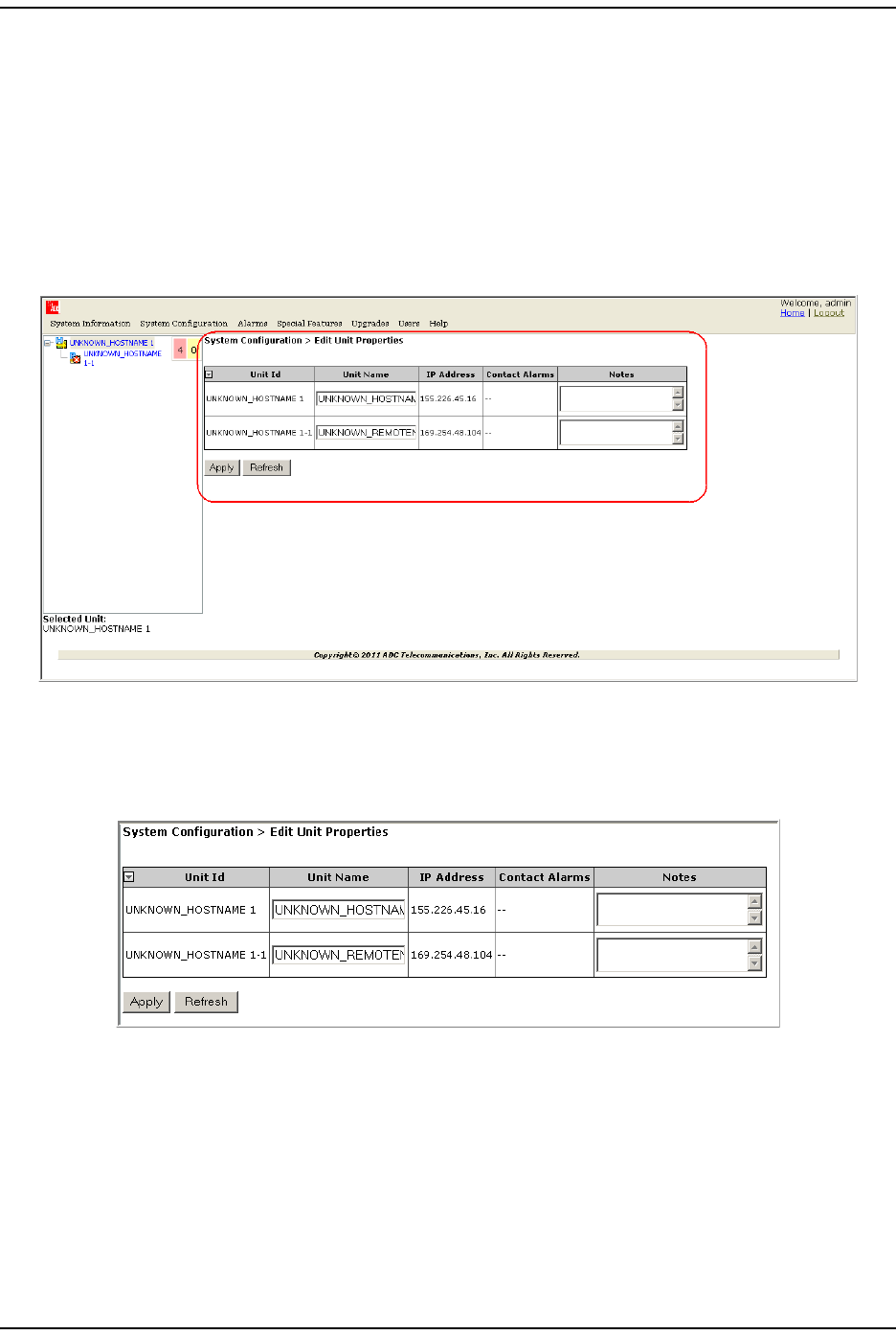
FlexWave Pr ism User Docum ent ation
Page xii FlexWave Prism Elem ent Managem ent Syst em 7.1 User Manual
© 2011 ADC Telecommunications, Inc ADCP- 77- 1 77 • I ssue 1 • July 2011
Document Graphics
This m anual docum ent s an EMS, t he feat ures of which display in a web browser
window, as described in “ How to Use t he EMS Graphical User I nt erface” on
page 40. To display the entire web browser would reduce the im age size in this
docum ent, which would reduce t he docum ent ’s usability. The screen graphics will
therefore focus on the elem ent of t he web page under discussion. I n m ost
inst ances, this will be the current view in t he EMS View fram e, which is encircled
in red in Figure 1.
Figure 1. EMS in Web Browser
For exam ple, when discussing the Edit Unit Properties page shown in Figur e 1, only
the Edit Unit Properties panel will be illust rated ( see Figure 2) .
Figure 2. Edit Unit Properties Panel

Preface
FlexWave Prism Elem ent Managem ent System 7.1 User Manual Page xiii
ADCP- 77- 1 77 • I ssue 1 • July 2011 © 2011 ADC Telecom m unications, I nc.
ABBREVIATIONS/ACRONYMS
This section defines abbreviations/ acronym s used in t his m anual.
Abbreviations/Acronyms Definition
AC Alternating Current
BDA Bi-Directional Amplifier
BER Bit Error Rate
BTS Base Transceiver Station
COM Common
CWDM Coarse Wavelength Division Multiplexer
DART Digital/Analog Radio Transceiver
DAS Distributed Antenna System
db Decibels
dBm decibel measured in reference to milliwatts
DC Direct Current
EMS Element Management System
FLM Forward Link Monitoring
FWD Forward
GUI Graphical User Interface
Id Identification
IF Intermediate Frequency
LNA Low Noise Amplifier
LPA Linear Power Amplifier
MHz Megahertz
MMW Millimeter Wave
sMicroseconds
NC Normally Closed
NIC Network-Interface Connection
nm Nanometer
NO Normally Open
OSP Outside Plant
Pkt Packet
PLL Phase-Locked Loop
PRU Prism Remote Unit
RDI Remote DART Interface
REV Reverse
RF Radio Frequency
RLM Reverse Link Monitoring
RSI Remote SeRF Interface
RX Receive
SeRF Serialized RF
SFP Small Form-Factor Pluggable

Abbr ev iat ions/ Acronym s
Page xiv FlexWave Prism Elem ent Managem ent Syst em 7.1 User Manual
© 2011 ADC Telecommunications, Inc ADCP- 77- 1 77 • I ssue 1 • July 2011
SNMP Simple Network Management Protocol
TX Transmit
UPS Uninterruptible Power Supply
URU URH Remote Unit
VLAN Virtual Local Area Network
VSWR Voltage Standing Wave Ratio
WDM Wavelength Division Multiplexer
Abbreviations/Acronyms Definition

FlexWave Prism Elem ent Managem ent System 7.1 User Manual Page 1
ADCP- 77- 1 77 • I ssue 1 • July 2011 © 2011 ADC Telecom m unications, I nc.
PART I
FLEXWAVE PRISM HARDWARE

Page 2 Flex Wave Prism Elem ent Managem ent System 7.1 User Manual
© 2011 ADC Telecommunications, Inc ADCP-77-177 • I ssue 1 • July 2011
I ntent ionally Blank Page

FlexWave Prism Elem ent Managem ent System 7.1 User Manual Page 3
ADCP- 77- 1 77 • I ssue 1 • July 2011 © 2011 ADC Telecommunications, Inc.
PRISM SYSTEM OVERVIEW
Prism System Overview ...........................................................................................................4
Fiber Opt ic Transport ..............................................................................................................10
Host Unit Overview ................................................................................................................11
Fan Module......................................................................................................................11
SeRF I I Module ................................................................................................................12
SeRF I I Module Ports ...................................................................................................12
SeRF I I Module LEDs ................................................................................................... 13
Host System I I Module ......................................................................................................14
Host Syst em I I Module Ports and Connectors ..................................................................14
Host System I I Module LEDs.........................................................................................15
DC Power Module ............................................................................................................. 15
Prism Remot e Units................................................................................................................16
PRU Ports and Connectors ( Bot t om of PRU) .......................................................................... 17
PRU Status LED ( Bottom of PRU) ........................................................................................18
PRU Com ponents.............................................................................................................. 19
RF Module Capabilit ies and GUI Represent ation ....................................................................21
DART Modules .......................................................................................................................24
Host DARTs .....................................................................................................................26
Host DART Slot s .........................................................................................................27
Host DART Connect ors and LEDs ...................................................................................28
Serialized RF (SeRF) Digit al Prot ocol ...................................................................................29
Sim ulcast Groups ............................................................................................................. 30
Use of Mult i Fibers ............................................................................................................31
E911 Support ...................................................................................................................32
Prism System Specifications ....................................................................................................33
This section provides a basic description of an ADC® FlexWave® Prism system .
Topics Page

Prism Syst em Overview
Page 4 Flex Wave Prism Elem ent Managem ent System 7.1 User Manual
© 2011 ADC Telecommunications, Inc ADCP-77-177 • I ssue 1 • July 2011
PRISM SYSTEM OVERVIEW
ADC’s FlexWave® Prism is a com pact radio head utilized for precision and m acro
gap coverage, which supports up t o four frequency bands, while delivering
high- perform ance coverage wit h end- t o-end m anagem ent. FlexWave Prism is
ideal for enhancing outdoor and indoor coverage in urban, suburban, canyons,
tunnels, cam puses, st adium s and other public venues.
A Prism syst em offers the following feat ures:
•ADC’s patent ed RF- over- fiber transport elim inates installation-dependent gain
or fiber length adjust m ents
•I m proved m anageabilit y for inst allation and upgrades
•Sm aller size t o ease placem ent and zoning approvals
•4G readiness wit h Four Band rem ot e, which is ideal for incorporating 2G and
3G services with needs of 4G technologies such as LTE
•The unique capabilit y t o support digit al RF as well as baseband com patibilit y
into a single fiber pair and rem ote radiating point
•Support for m illim eter wave backhaul
•Wit h its unique use of wideband digit al RF transport , FlexWave Prism delivers
reliable and consist ent perform ance in all environm ents. Signals are not
affected by reflect ion, dispersion, or frequency att enuation over fiber.
FlexWave Prism delivers a reliable signal at every rem ot e location.
The ADC FlexWave Prism fam ily of products is a Dist ribut ed Antenna Syst em
( DAS) that provides ADC’s patented t echnology—bidirect ional t r ansport of
digit ized RF spect rum over fiber. The high- speed digitalizat ion of a wideband
portion of spectrum allows for transport of RF signals over extended distances,
wit hout the RF degradation that norm ally result s when analog syst em s are
im pact ed by opt ical effects. The basic function of the FlexWave Prism plat form is
to transport via fiber optic cable RF signals from a Base Transceiver Stat ion ( BTS)
to an ant enna int erface allowing com m unication t o a m obile device. Mult iple BTS
com m unication paths are allowed over a single Prism syst em .
A very basic Prism syst em consist s of a Host Unit (Host) and a Prism Rem ote Unit
( PRU) .
•The Host is a t hree rack unit high chassis wit h m ultiple cards t hat m ount s in a
st andard equipm ent rack.
•The PRU consists of m ult iple elect ronic and optical m odules m ounted in an
outdoor enclosure.
On an optional basis, the Prism system supports reverse path diversity. I n
addit ion, various accessory item s such as a passive Wavelength Division
Mult iplexer ( WDM) system and a Coarse Wavelength Division Mult iplexer (CWDM)
syst em are available as accessories.
Control and m onit oring functions are provided by the FlexWave Elem ent
Managem ent System (EMS) .
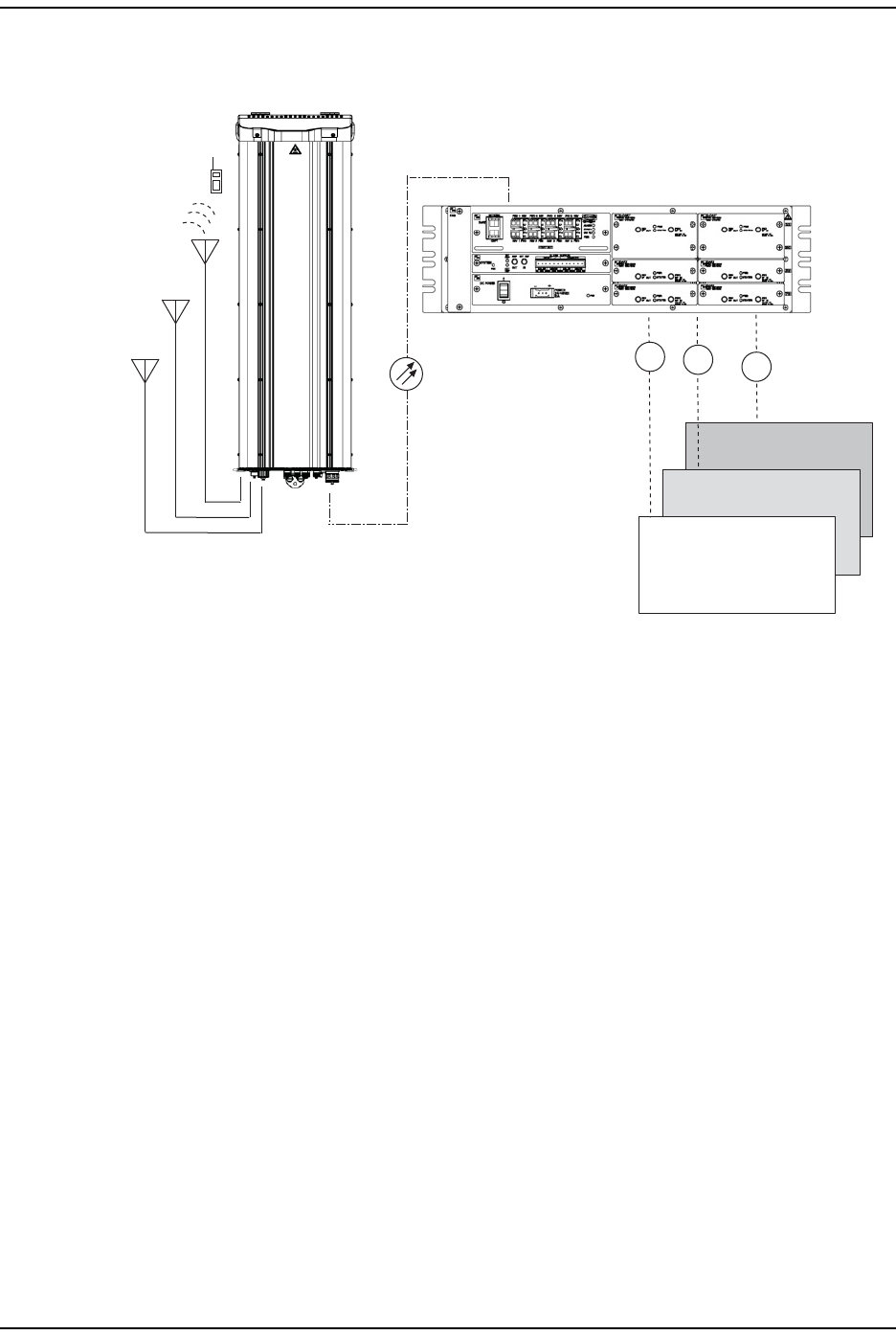
Prism Syst em Overview
FlexWave Prism Elem ent Managem ent System 7.1 User Manual Page 5
ADCP- 77- 1 77 • I ssue 1 • July 2011 © 2011 ADC Telecom m unications, I nc.
Exam ples of FlexWave Prism Syst em s are shown in Figure 1, Figure 2 on page 6,
and Figure 3 on page 7.
Figure 1. Three Bands to One PRU (No Simulcast)
Base Transceiver Stations
Frequency Band A
RF
Antenna
Frequency Band A
Antenna
Frequency Band B
Antenna
Frequency Band C
Host Unit
Tri-Band Remote Unit
Frequency Band B
RF
Frequency Band C
RF
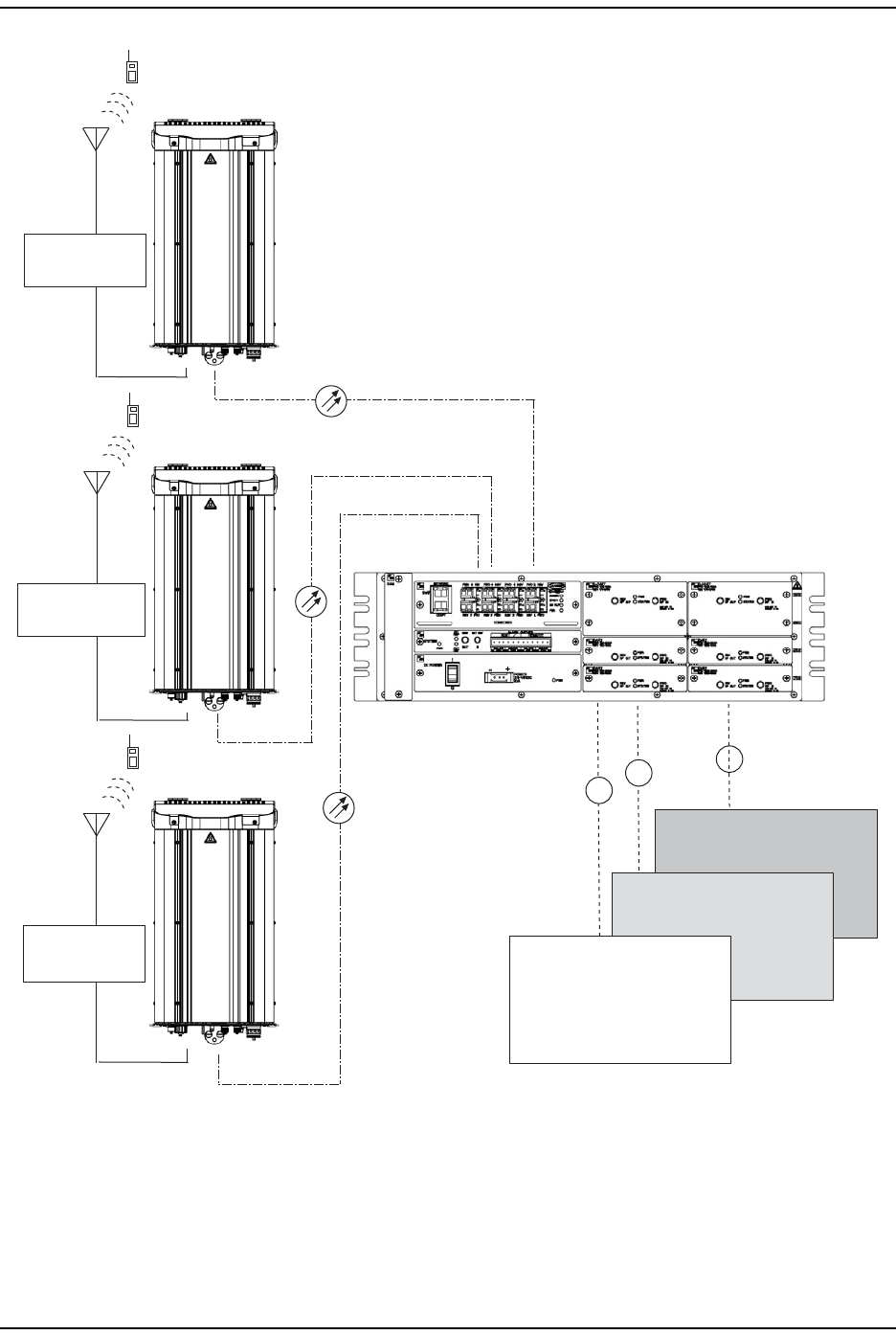
Prism Syst em Overview
Page 6 Flex Wave Prism Elem ent Managem ent System 7.1 User Manual
© 2011 ADC Telecommunications, Inc ADCP-77-177 • I ssue 1 • July 2011
Figure 2. Multiple Point-to-Point Configuration
(One Band per PRU, Three Nodes)
Host Unit
RF
Base Transceiver Stations
Frequency Band A
Sector G
Frequency Band A
Sector B
Frequency Band A
Sector A
RF
RF
Antenna
Frequency Band A
Sector G
Antenna
Frequency Band A
Sector B
Antenna
Frequency Band A
Sector A
Three Single-Band Remotes
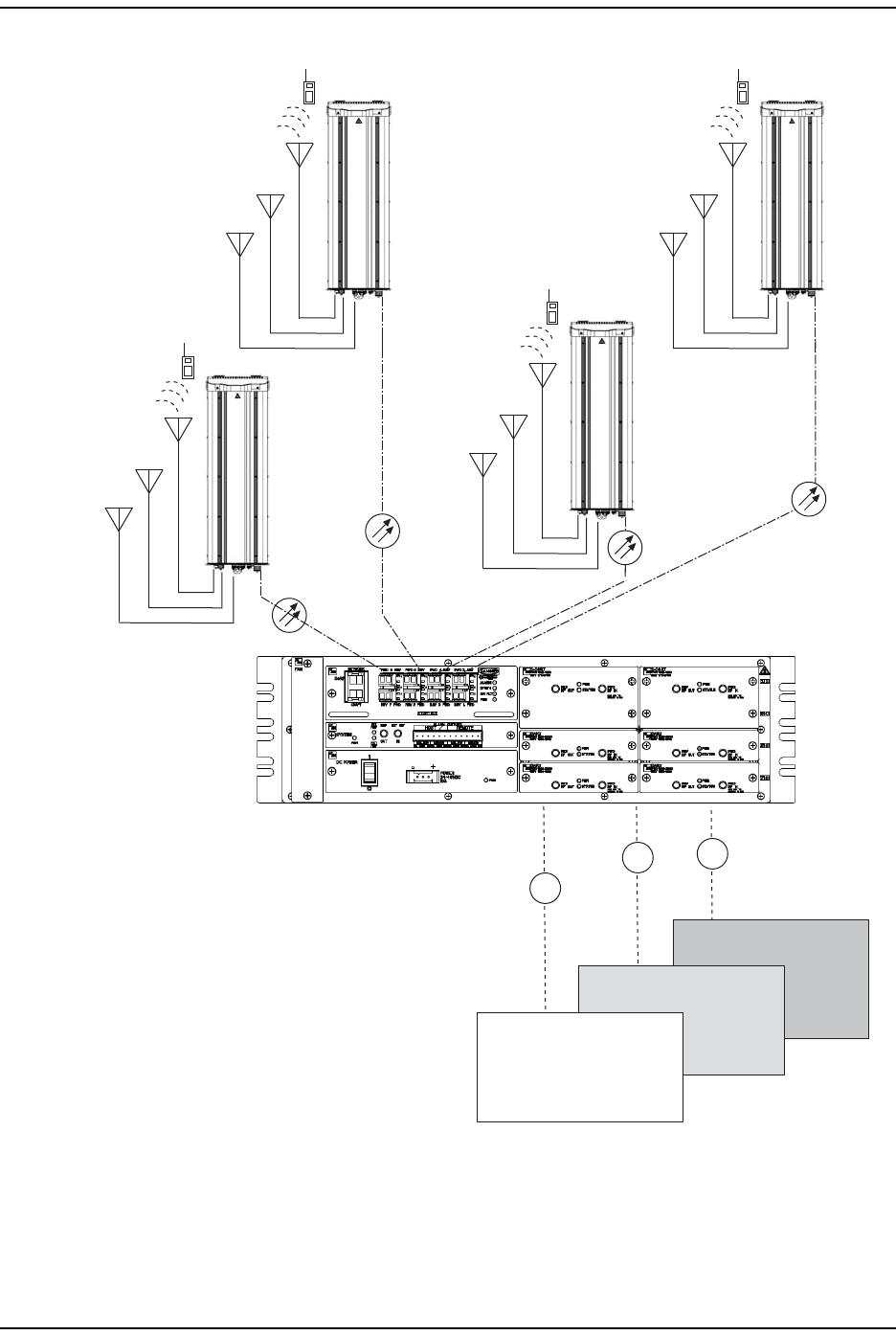
Prism Syst em Overview
FlexWave Prism Elem ent Managem ent System 7.1 User Manual Page 7
ADCP- 77- 1 77 • I ssue 1 • July 2011 © 2011 ADC Telecom m unications, I nc.
Figure 3. Four PRU Simulcast, Three Frequency Bands
Each link consist s of a Host that provides the int erface between t he base stat ion
RF port s and t he opt ical fiber, and at least one Rem ot e t hat provides t he interface
bet ween t he opt ical fiber and the rem ot e ant enna.
RF
RF
Host Unit
Base Transceiver Stations
Frequency Band B
Frequency Band A
Four Tri-Band Remotes
Antenna Frequency
Band A
Antenna Frequency
Band B
Antenna Frequency
Band C
Antenna Frequency
Band A
Antenna Frequency
Band B
Antenna Frequency
Band C
Antenna Frequency
Band A
Antenna Frequency
Band B
Antenna Frequency
Band C
Antenna Frequency
Band A
Antenna Frequency
Band B
Antenna Frequency
Band C
RF
Frequency Band C
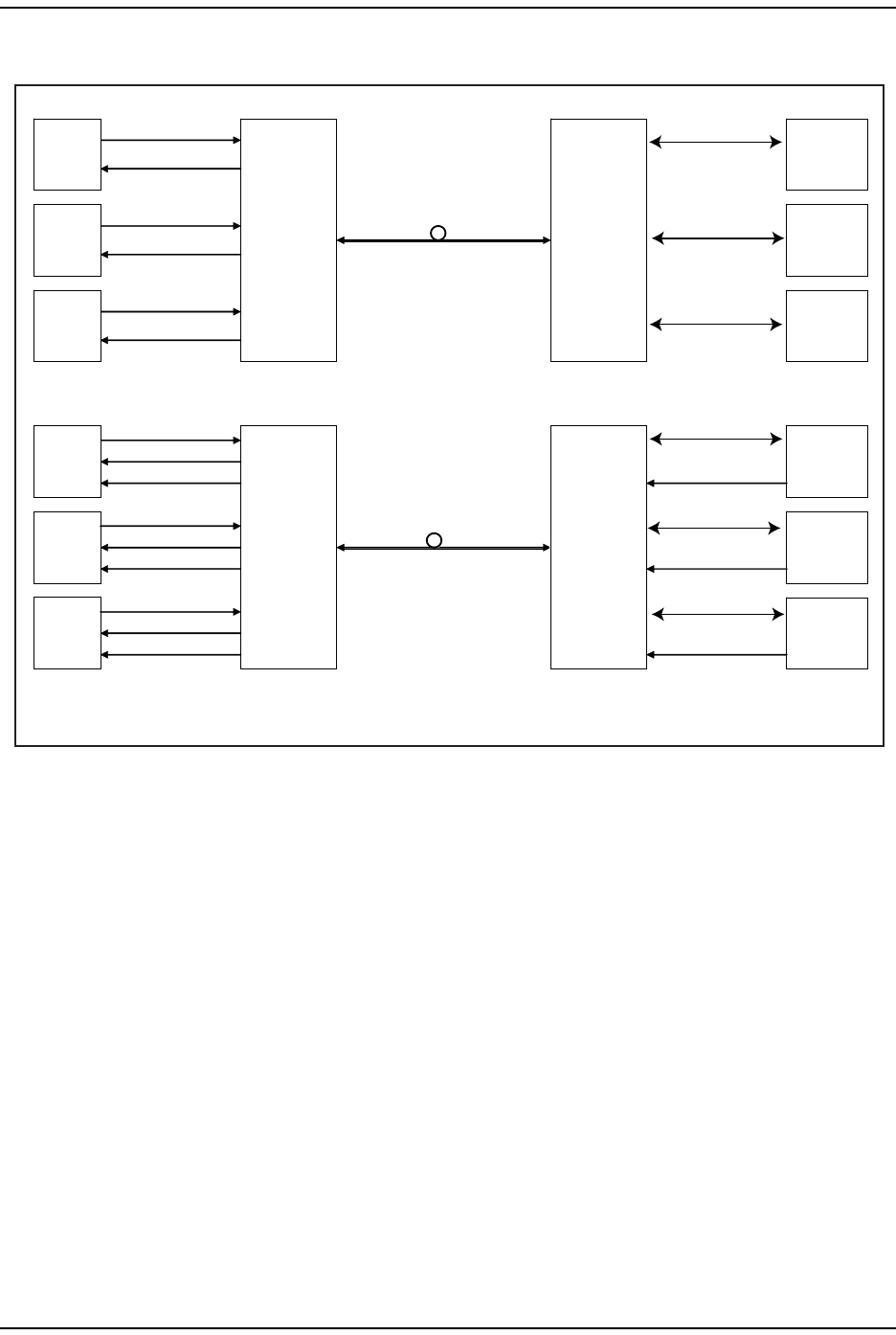
Prism Syst em Overview
Page 8 Flex Wave Prism Elem ent Managem ent System 7.1 User Manual
© 2011 ADC Telecommunications, Inc ADCP-77-177 • I ssue 1 • July 2011
A block diagram of a point-to- point syst em is shown in Figure 4.
Figure 4. FlexWave Tri-Band Prism Block Diagram
FlexWave
Host
FWD RF IN
REV RF OUT
BTS 1
Antenna
Interface
BTS 1
BTS 2
BTS 3
Antenna
Interface
BTS 2
Antenna
Interface
BTS 3
NON-DIVERSITY
FWD RF IN
REV RF OUT
BTS 1
Antenna
Interface
BTS 1
BTS 2
BTS 3
Antenna
Interface
BTS 2
Antenna
Interface
BTS 3
DIVERSITY
REV DIV RF OUT REV DIV RF IN
REV DIV RF IN
REV DIV RF IN
FWD RF IN
REV RF OUT
REV DIV RF OUT
FWD RF IN
REV RF OUT
REV DIV RF OUT
FWD RF IN
REV RF OUT
FWD RF IN
REV RF OUT
FlexWave
Host
FlexWave
Remote
FlexWave
Remote
FWD RF OUT
REV RF IN
FWD RF OUT
REV RF IN
FWD RF OUT
REV RF IN
FWD RF OUT
REV RF IN
FWD RF OUT
REV RF IN
FWD RF OUT
REV RF IN
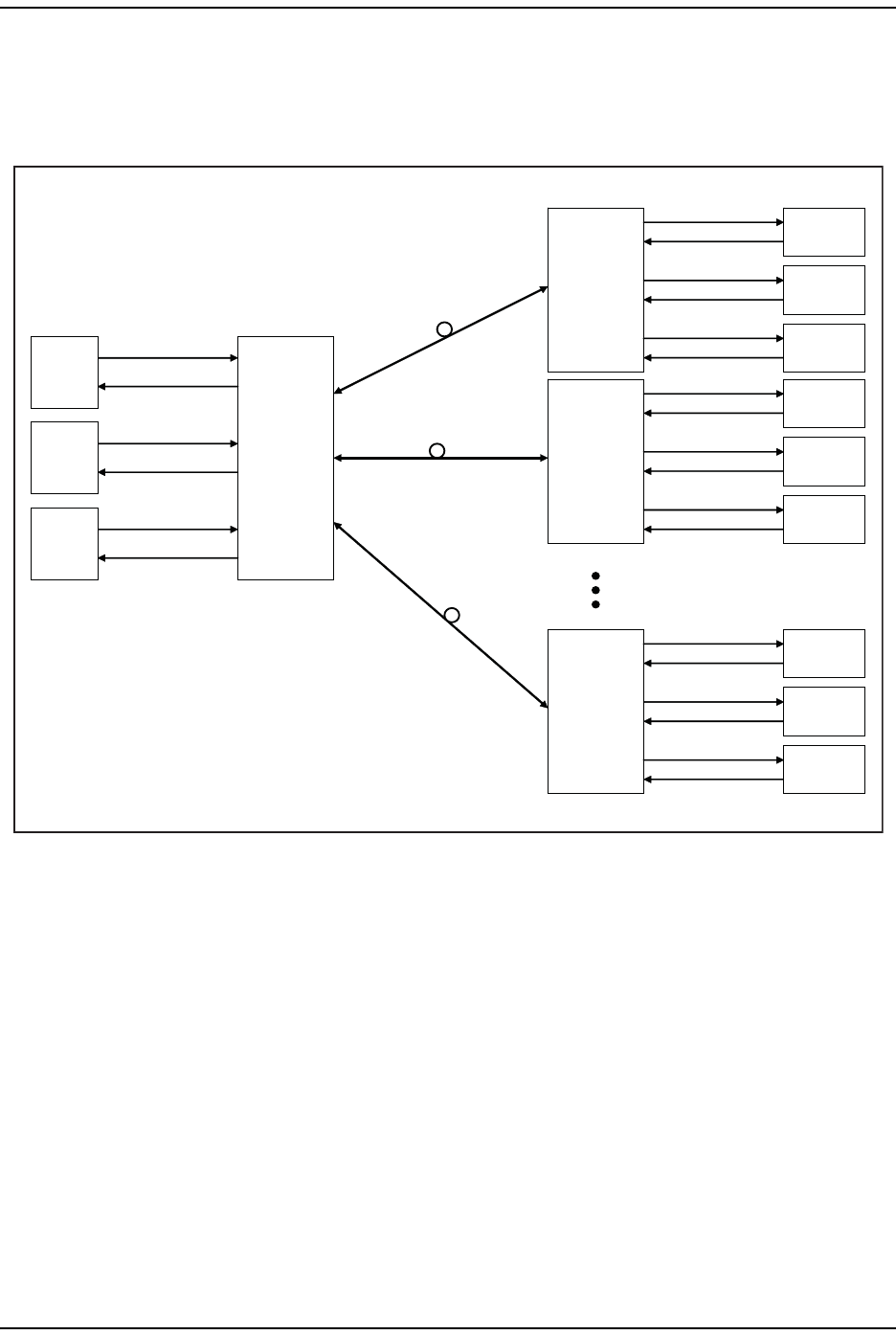
Prism Syst em Overview
FlexWave Prism Elem ent Managem ent System 7.1 User Manual Page 9
ADCP- 77- 1 77 • I ssue 1 • July 2011 © 2011 ADC Telecom m unications, I nc.
The basic function of FlexWave Prism sim ulcast (point-to- m ult ipoint ) is to
transport , via fiber opt ic cable, RF signals from a BTS to m ult iple antenna
interfaces allowing com m unication t o a m obile device ( see Figure 5). Up t o 8
sim ulcast Rem ote Unit s are support ed by each Host Unit .
Figure 5. System Block Diagram for Eight-Way Simulcast
FlexWave
Host
FWD RF IN
REV RF OUT
BTS 1
BTS 2
BTS 3
FWD RF IN
REV RF OUT
FWD RF IN
REV RF OUT
FlexWave
Remote 1
Antenna
Interface
BTS 1
FWD RF OUT
REV RF IN
FWD RF OUT
REV RF IN
FWD RF OUT
REV RF IN
FWD RF OUT
REV RF IN
FWD RF OUT
REV RF IN
FWD RF OUT
REV RF IN
FWD RF OUT
REV RF IN
FWD RF OUT
REV RF IN
FWD RF OUT
REV RF IN
FlexWave
Remote 2
FlexWave
Remote 8
Antenna
Interface
BTS 2
Antenna
Interface
BTS 3
Antenna
Interface
BTS 1
Antenna
Interface
BTS 2
Antenna
Interface
BTS 3
Antenna
Interface
BTS 1
Antenna
Interface
BTS 2
Antenna
Interface
BTS 8
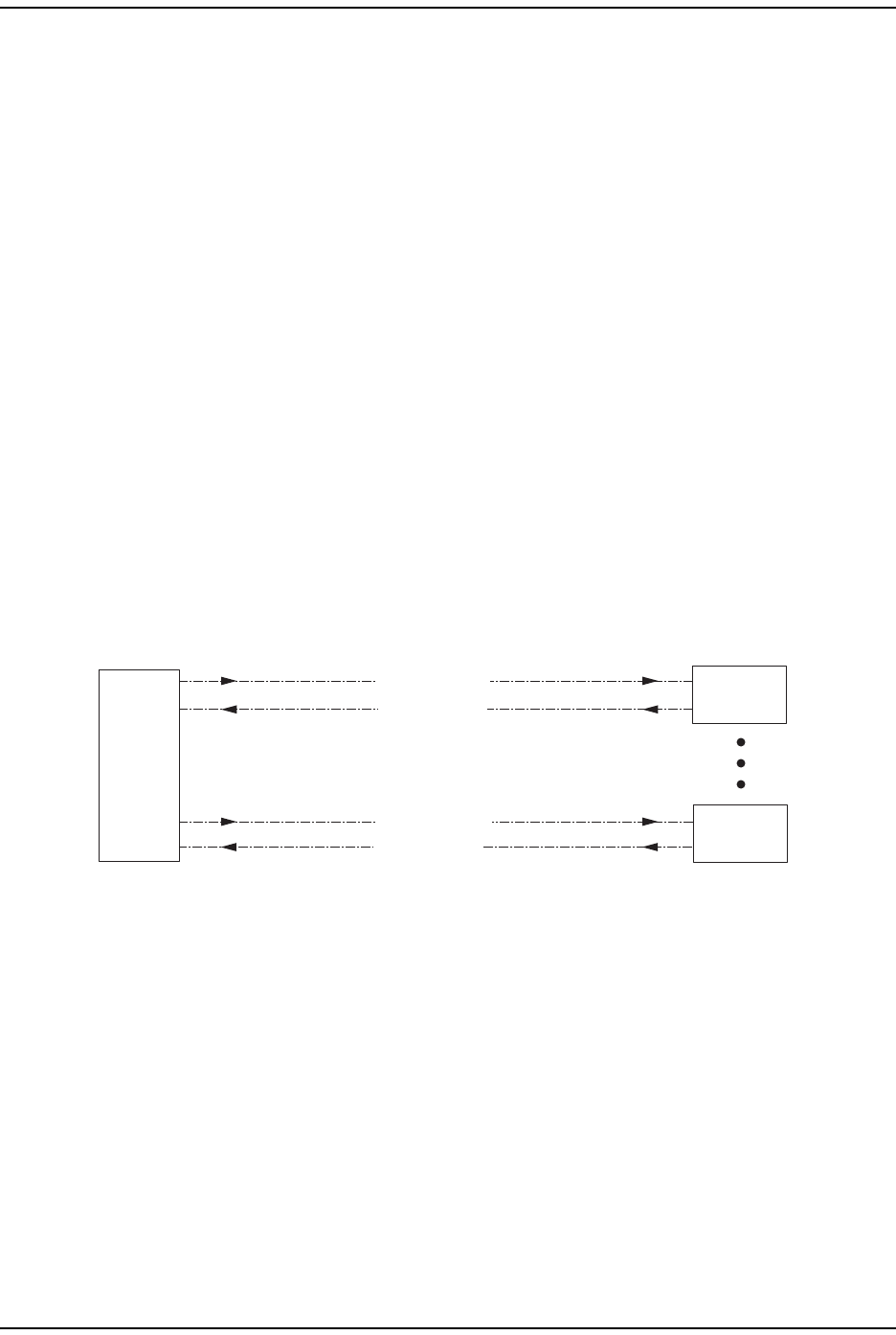
Fiber Optic Transport
Page 10 FlexWave Prism Elem ent Managem ent Syst em 7.1 User Manual
© 2011 ADC Telecommunications, Inc ADCP-77-177 • I ssue 1 • July 2011
FIBER OPTIC TRANSPORT
I n a FlexWave Prism syst em , each BTS provides the RF channel inputs and out puts
for a designated sector. Each Host m ay be interfaced wit h one or m ore Base
Transceiver Stat ion ( BTS) .
On the forward path, the Host receives Analog RF signals from the BTS, digitizes
the designat ed RF bands, and then t ransport s them over single-m ode fiber to up
to 8 Rem ot e Unit s. The Rem ot e Unit ( s) receives the digitized spect rum from the
Host and converts t he spect rum back into an analog RF signal t o be dist ribut ed via
an ext ernally m ount ed ant enna system .
On the reverse pat h, the Rem ot e Unit digitizes t he designated RF spectrum and
digit ally transport s it over single m ode fiber or Millim eter Wave ( MMW) to the
Host . The Host receives the digitized RF signals from the Rem ot e Unit and converts
them back to Analog RF for the BTS.
I n a t ypical Prism syst em the Host is connect ed t o t he Rem ote using t wo
single- m ode opt ical fibers. One fiber is used to transport t he forw ard pa t h optical
signal and a second fiber is used to t ransport the r everse pat h optical signal.
Because the opt ical signal is digit al, t he input and output RF signal levels at t he
Host or the Rem ot e are not dependent on t he level of t he opt ical signal or the
lengt h of the opt ical fiber. A diagram of the st andard fiber opt ic transport syst em
for both a non- diversity and diversity system is shown in Figure 6.
Figure 6. Standard Fiber Optic Transport Application
The m axim um lengt h of t he opt ical links is dependent on t he loss specifications of
the optical fiber and the losses im posed by the various connectors and splices. The
syst em provides an opt ical budget of 2 5 dB (t ypical) when used wit h 9/ 125
single- m ode fiber. There m ust be at least 10 dB of optical loss t o prevent
over- driving and possible dam age t o t he opt ical receiver.
NOTE: The RF modulation used determines the maximum fiber length between the Host and
Remote units, which is dependent on how much delay that modulation type will handle.
77073-008
Remote
Unit
Forward Path
Reverse Path
Non-Diversity Fiber Optic Link
Forward Path
Diversity Fiber Optic Link
Reverse Path
And
Diversity Reverse Path
Host
Unit
Remote
Unit
Up To
Eight
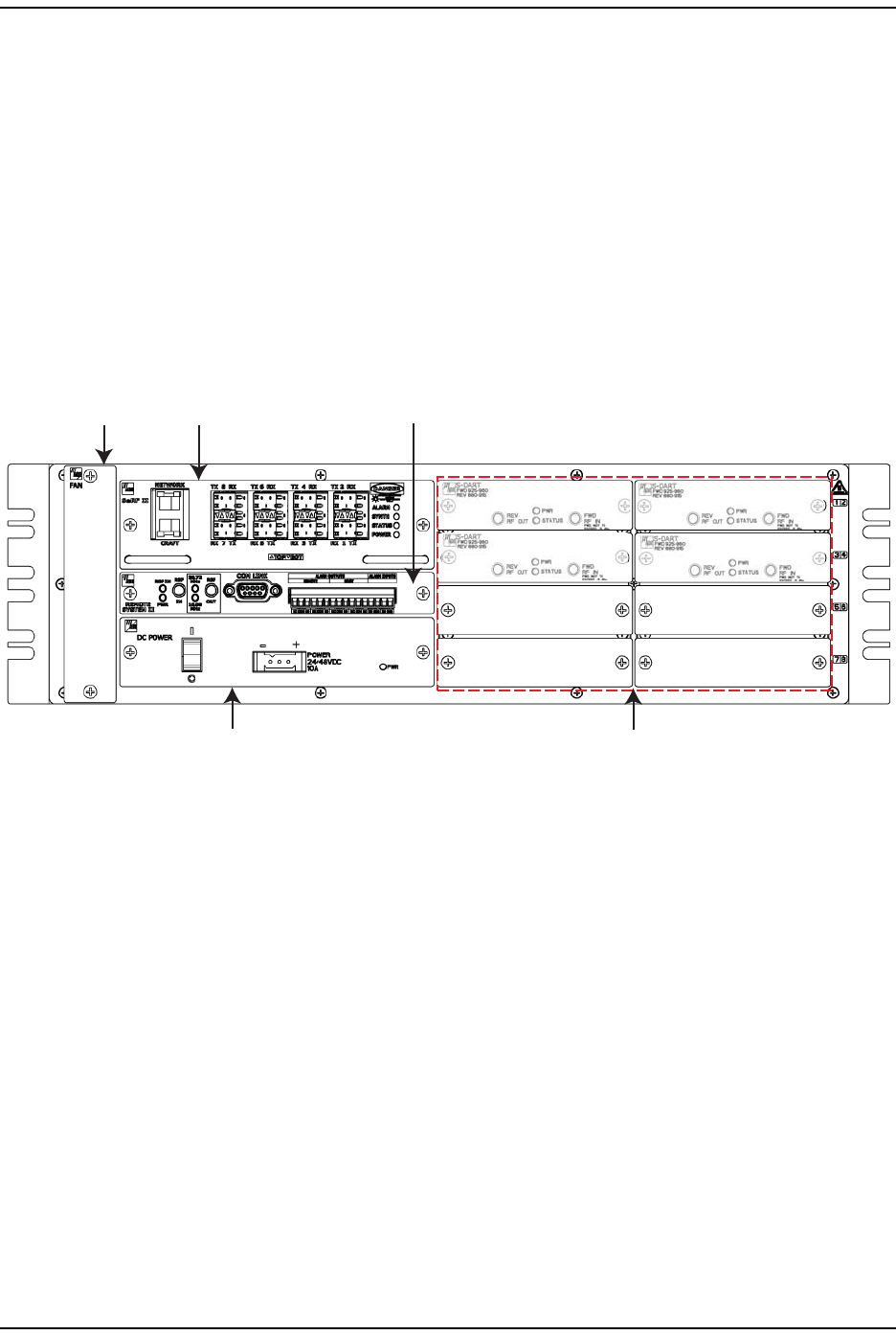
Prism Syst em Overview
FlexWave Prism Elem ent Managem ent Syst em 7.1 User Manual Page 11
ADCP- 77- 1 77 • I ssue 1 • July 2011 © 2011 ADC Telecom m unications, I nc.
HOST UNIT OVERVIEW
The rack- m ountable Host is t ypically located wit h the RF source—a Base
Transceiver St at ion ( BTS) . The Host is DC powered and supports up to eight BTS
interfaces t hrough DART ( Digit al/ Analog Radio Transceiver) cards. ( For further
inform at ion on DART Modules, see “ DART Modules” on page 24.)
The Host is designed for use wit hin a non- condensing indoor environm ent, such
as inside a base-stat ion shelt er, Cent ral Office, wiring closet , or a
cont rolled-environm ent cabinet. I t is installed into a 19- or 23- inch, rack- m ounted
chassis, t hat is 9- inches deep and can hold up to three units. All cont rols,
connectors, and indicat ors, except for t he grounding point , are accessible on front
of t he Host . Figure 7 shows t he m ain elem ents of the Host .
Figure 7. Host Front Panel
NOTE: The Host comprises a Fan Assembly, a SeRF II Board Module, a Host System II Module,
and a DC Power Module. These modules are pre assembled in the Host chassis at the
factory. This document describes them as separate modules for reference only.
Fan Module
The Fan Module, m ounted on the left side of the Host, cont inuously blows cool air
into the Host enclosure, and vents hot air out of the chassis on t he right . An alarm
is generated if a high- t em perature condition occurs. The Fan Module is field
replaceable ( see the Prism Host Unit I nst allat ion Guide, ADCP-77-089) .
Fan
Assembly
SeRF II
Module
System II
Board Module
DC Power
Module
Slots 1 - 8 for DART cards
(Slots 1 - 4 are occupied)
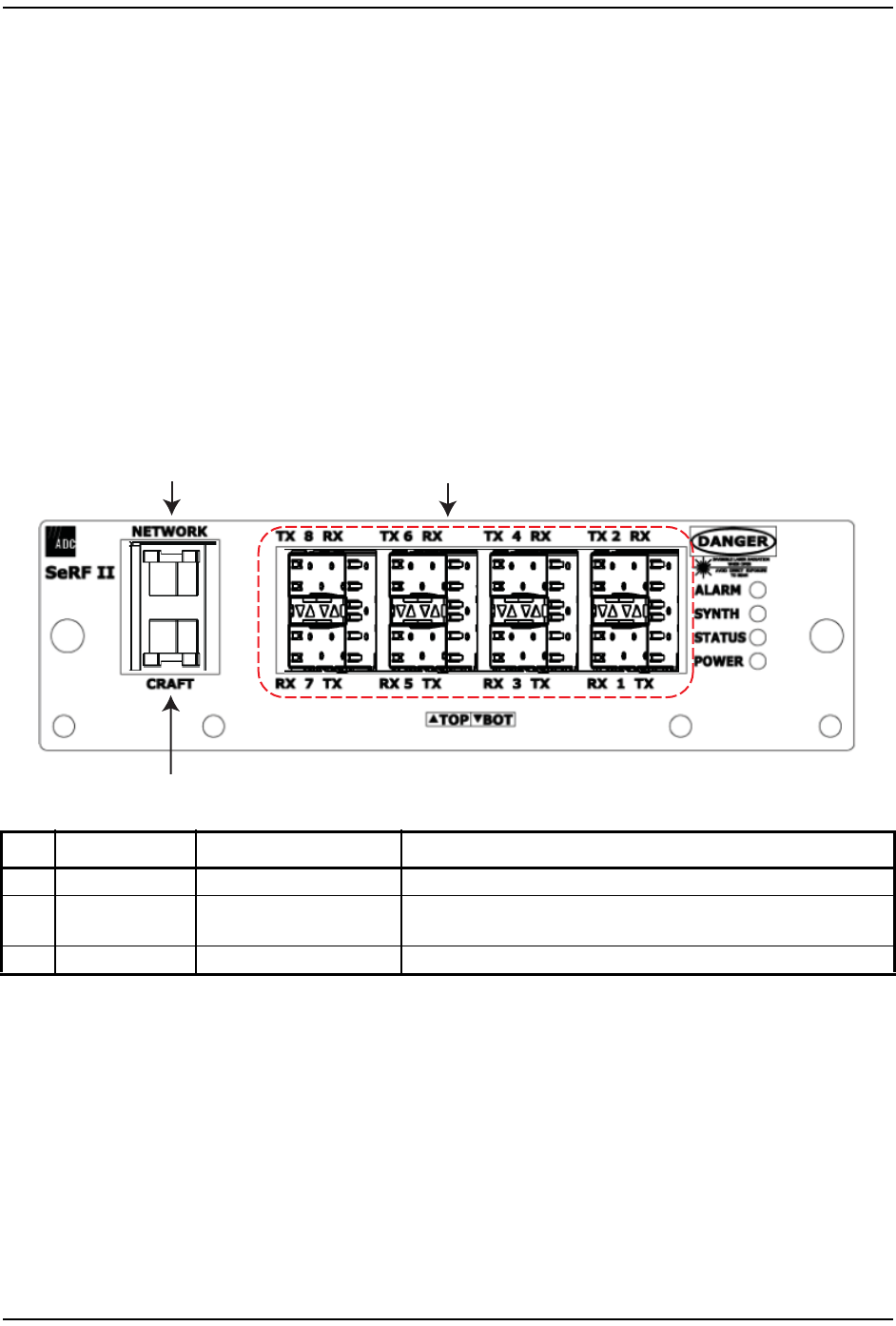
Host Unit Overview
Page 12 FlexWave Prism Elem ent Managem ent Syst em 7.1 User Manual
© 2011 ADC Telecommunications, Inc ADCP-77-177 • I ssue 1 • July 2011
SeRF II Module
The SeRF I I Module:
•m anages com m unicat ions and alarm s
•receives digit ized signals from the DART and sends the digitized RF bands t o
the designated PRU
•receives digit ized RF signals from t he PRU and sends the digitized RF signal to
the DART for conversion from Digit al RF t o Analog RF for the BTS/ BDA
•suppor t s eight Small Form - factor Pluggable (SFP) optical transceivers
•provides t wo Et hernet interfaces.
SeRF II Module Ports
Ref # Component Device Function
1Network port RJ-45 jack (female) Networking access to an external DHCP server
2TX/RX Optical port
(1–8)
LC (flat-polished) connector
(single-mode)
Input/output connection points for Ports 1 through 8 Transmit (TX) and
Receive (RX) optical fiber pairs
3Craft port RJ-45 jack (female) Local Ethernet access to the Host
12
3
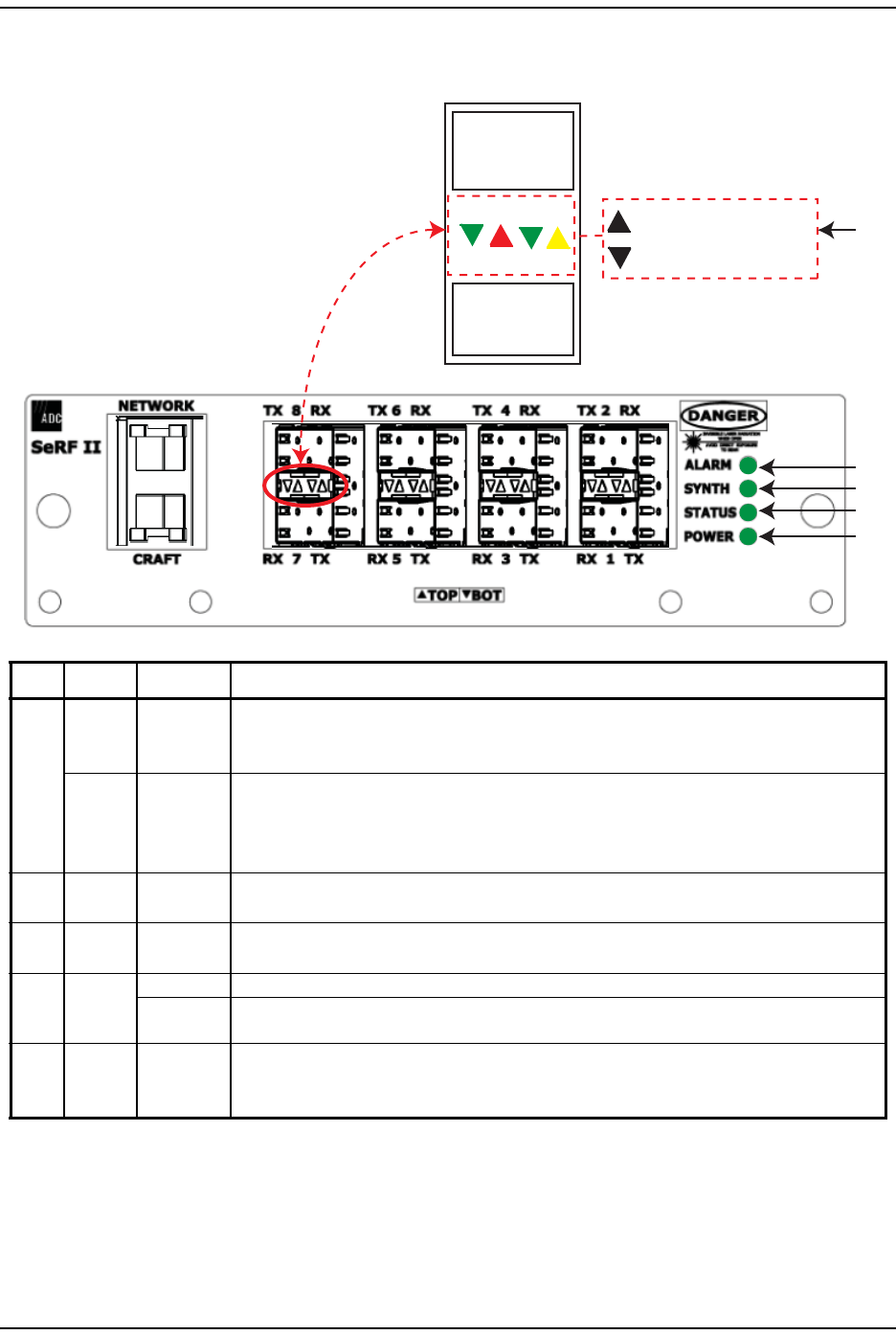
Prism Syst em Overview
FlexWave Prism Elem ent Managem ent Syst em 7.1 User Manual Page 13
ADCP- 77- 1 77 • I ssue 1 • July 2011 © 2011 ADC Telecom m unications, I nc.
SeRF II Module LEDs
Ref # LED LED Color Description
1
SFP TX •OFF
• GREEN
•RED
• No Small Form-Factor Pluggable (SFP) present
• SFP is present and the FPGA internal Phase-Locked Loop (PLL) is locked
• SFP is present and the FPGA internal PLL is not locked
SFP RX •OFF
• GREEN
•AMBER
•RED
• No SFP present
• Receiver has locked and framed to the incoming signal
• Receiver has light, but is not locked to the incoming frequency or not framed
• Receiver has no light
2ALARM • GREEN • No major alarm is present in the system
• RED • Initial bootup sequence, or a major alarm is present in the system
3SYNTH • GREEN • Locked
• RED • Unlocked
4STATUS
• GREEN • No alarm for the SeRF II Module
• RED • Initial bootup sequence and should become GREEN within 1 minute; if RED after bootup, a
Major alarm exists for the SeRF II Module
5POWER
• GREEN • Power OK and operating properly
• RED • Power supply out of tolerance
• OFF • No power present
SFP8
Tx Rx
SFP7
Tx
Rx
LEDs for SFP in top port 1
2
3
4
5
LEDs for SFP in bottom port
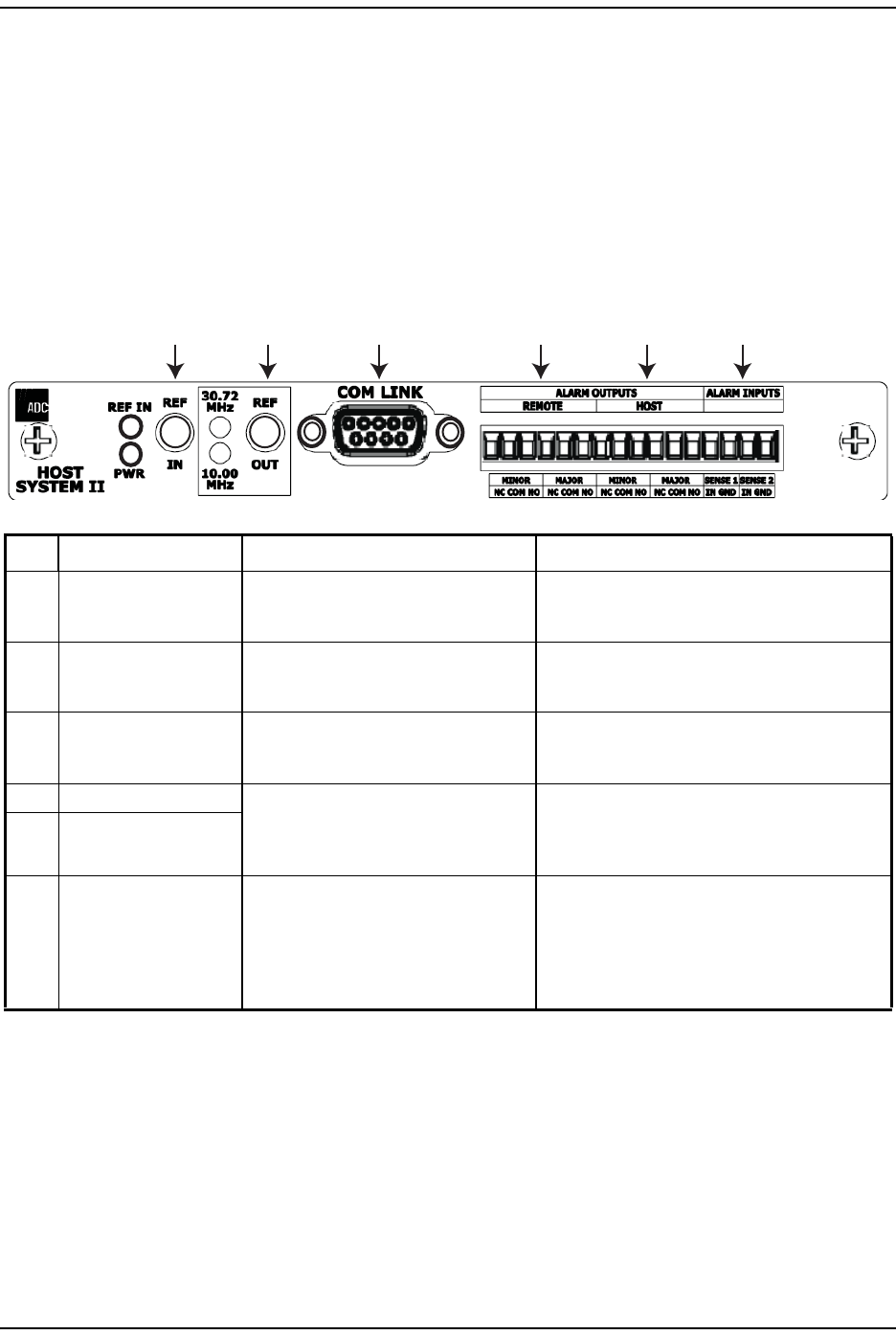
Host Unit Overview
Page 14 FlexWave Prism Elem ent Managem ent Syst em 7.1 User Manual
© 2011 ADC Telecommunications, Inc ADCP-77-177 • I ssue 1 • July 2011
Host System II Module
The Host Syst em I I Module:
•provides out put dry alarm cont acts for report ing alarm s t o an external
m anagem ent system
•can output t he reference clock t o a daisy- chained Host.
Host System II Module Ports and Connectors
Ref # Component Device Function
1REF IN connector QMA-Type female RF coaxial connector 10 MHz reference clock input that may be used to
synchronize between multiple Hosts in a
daisy-chain configuration.
2REF OUT connector QMA-Type female RF coaxial connector 10 MHz reference clock output that may be used to
synchronize between multiple Hosts in a
daisy-chain configuration.
3 COM LINK connector DB9 female connector Not applicable to the Prism Host. The COM Link is
only used when the System II Board is configured
as a Remote System II Board.
4Alarm Outputs—PRU Twelve position terminal block.
Screw-type terminal connector
(14–26 AWG)
Connection points for a major and minor dry alarm
contacts. Includes normally closed (NC), common
(COM), and normally open (NO) wiring
connections.
5
Alarm Outputs—Host
6
Alarm Inputs
Two contact closure inputs Connection points for monitoring external devices,
which allows the Alarm connector to monitor the
output contact closures from an Uninterruptible
Power Supply (UPS) or a Bi-Directional Amplifier
(BDA). This feature is currently not supported by
Prism systems.
12 3 4 5 6
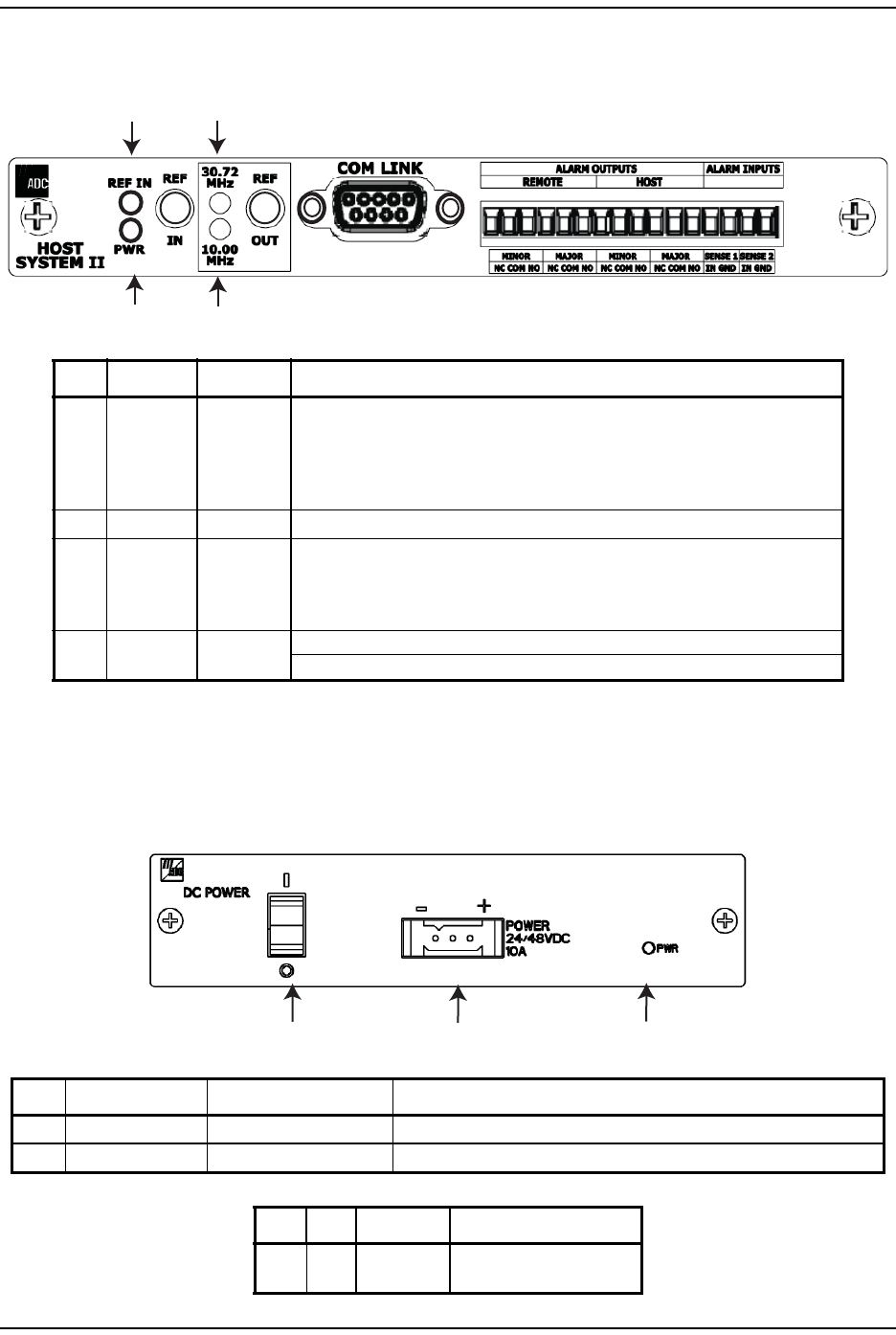
Prism Syst em Overview
FlexWave Prism Elem ent Managem ent Syst em 7.1 User Manual Page 15
ADCP- 77- 1 77 • I ssue 1 • July 2011 © 2011 ADC Telecom m unications, I nc.
Host System II Module LEDs
DC Power Module
The DC Power Module convert s ± 24 - ± 48 VDC t o t he DC volt ages used by t he
Host m odules.
Ref # LED LED Color Description
1REF IN
• Green • An external reference has been selected in the Prism Element Management
System GUI. Once this selection has been made in the GUI, the REF IN LED
is green, regardless of the presence of a signal on the REF IN connector.
• Off • No external reference has been selected in the Prism Element Management
System GUI.
230.72 MHz Off For this release, this LED will always be off in a Prism Host Unit.
310 MHz
• Green • The system is configured to output a 10MHz signal on the Ref Out connector.
(The input of an external 10MHz clock on the Ref In connector is indicated by
the REF In LED.)
• Off • External 10 MHz reference disabled.
4PWR • Green • Host System II board is receiving power.
• Off • Host System II board is not receiving power.
Ref # Component Device Function
1ON/OFF Switch Rocker switch Turns Host power on/off
2POWER connector Three position connector 10A connector for DC power wiring; FCC qualification meets 21-60 VDC
Ref # LED LED Color Description
3PWR • Green • DC Power Supply OK
• Red • DC Power Supply Fault
1 2
3
4
123
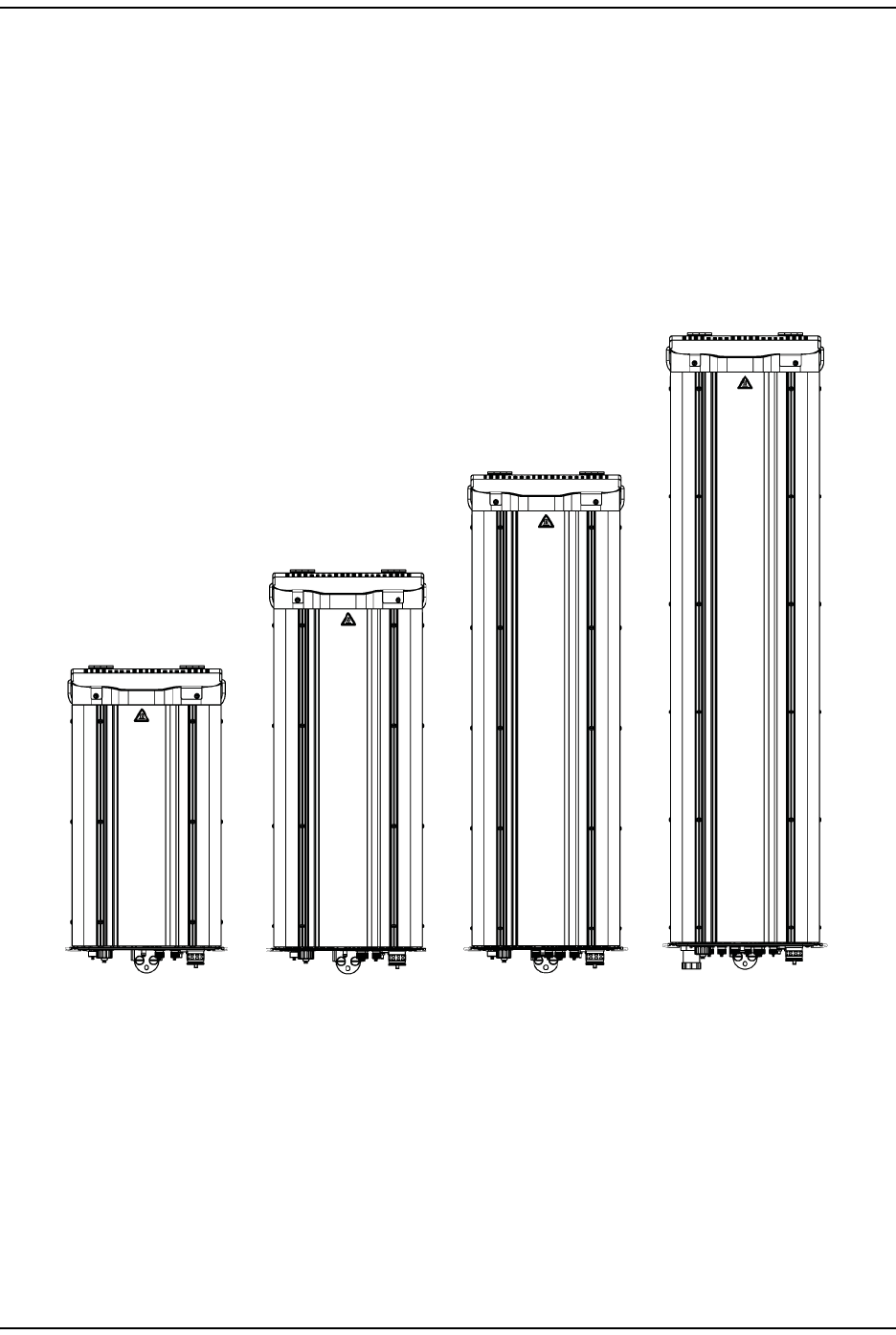
Prism Rem ot e Unit s
Page 16 FlexWave Prism Elem ent Managem ent Syst em 7.1 User Manual
© 2011 ADC Telecommunications, Inc ADCP-77-177 • I ssue 1 • July 2011
PRISM REMOTE UNITS
The Prism Rem ot e Unit (PRU) , shown in Figure 8, cont rols RF em issions, int erfaces
wit h the FlexWave Host and perform s the opt ical t o electrical conversions for
transport to t he antennas. The PRU is an I P- 65 rat ed enclosure that houses the
elect ronic assem blies such as t he RF Module Group, SeRF assem bly and AC/ DC
power supplies, and seals out dirt and m oist ure. The PRU uses fans locat ed on t he
top of each unit t o cool the chassis. The antenna cable connectors, fiber
connectors, AC power connect or, and the unit st at us indicator are locat ed on t he
bott om of the unit.
Figure 8. Prism Remote Units (PRUs)
The FlexWave Rem ote receives on t he forward path t he digit ized spectrum from
the Host and converts t he spectrum back int o an RF signal to be dist ribut ed via an
externally m ount ed ant enna syst em . On the reverse path, the Remot e digit izes
the designated RF spect rum and digitally transports it over single- m ode fiber or
Millim eter Wave (MMW) to the Host. The PRU also provides RF int erface (antenna
port) for the ant ennas, and accept s AC power input.
Single-Band
Remote
Dual-Band
Remote
Tri-Band
Remote
Quad-Band
Remote
77152-007
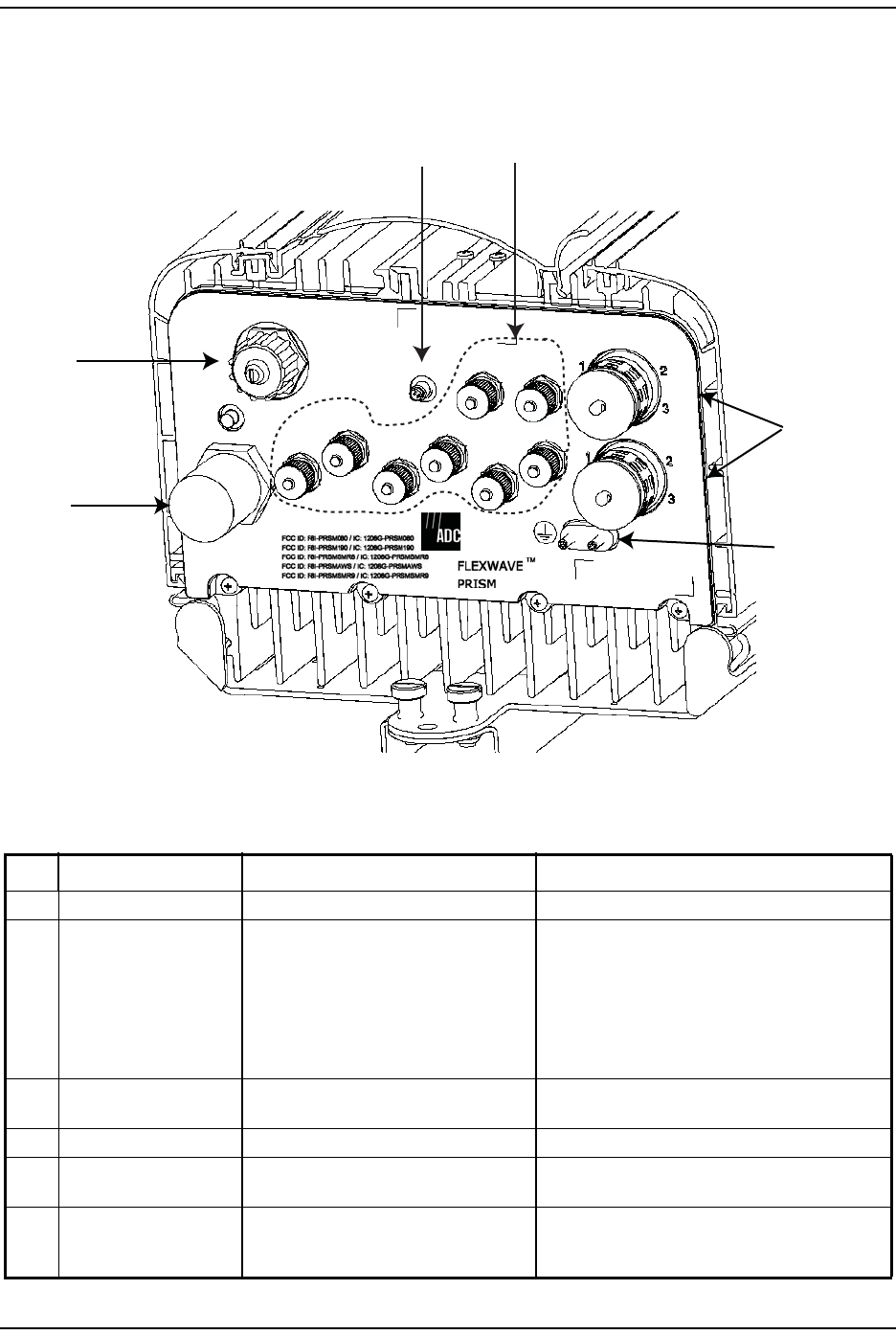
Prism Syst em Overview
FlexWave Prism Elem ent Managem ent Syst em 7.1 User Manual Page 17
ADCP- 77- 1 77 • I ssue 1 • July 2011 © 2011 ADC Telecom m unications, I nc.
PRU Ports and Connectors (Bottom of PRU)
Ref # Component Device Function
1Aux Connector Four contact closure inputs Connection points for external alarm inputs.
2Antenna Connectors Eight 50 N-Type (female) connectors • Connection points between the PRU and up to
four antennas are labeled as Mod X TXO/RXO
(where the first X can be A, B, C, or D).
• Connection points between the PRU and
Diversity receive for RF power from the antenna
are labeled as Mod X RX1 (where the first X can
be A, B, C, or D).
3Fiber Connectors ProAx connectors that provide four BX5
connectors
Connection points between the PRU and the
Outside Plant (OSP) box.
4Dual-Ground Connector Ground connector Grounds the PRU.
5AC Power Port Sealed 3-pin port Connection point between the PRU and an AC
power junction box.
6
Network Connector Port
RJ-45 female connector IP servicing between the Host and PRU(s); allows
communications with the internal processor and
transfer of service data to the optical protocol.
NETWORK
AUX.
MOD A
RX1
MOD A
TX0/RX0
FIBER 1
FIBER 2
MOD B
TX0/RX0
MOD B
RX1
MOD C
TX0/RX0
MOD D
TX0/RX0
MOD C
RX1
MOD D
RX1
POWER
100-240 VAC
50-60 Hz
16 AMPS
Bottom of a PRU
6
5
3
4
12
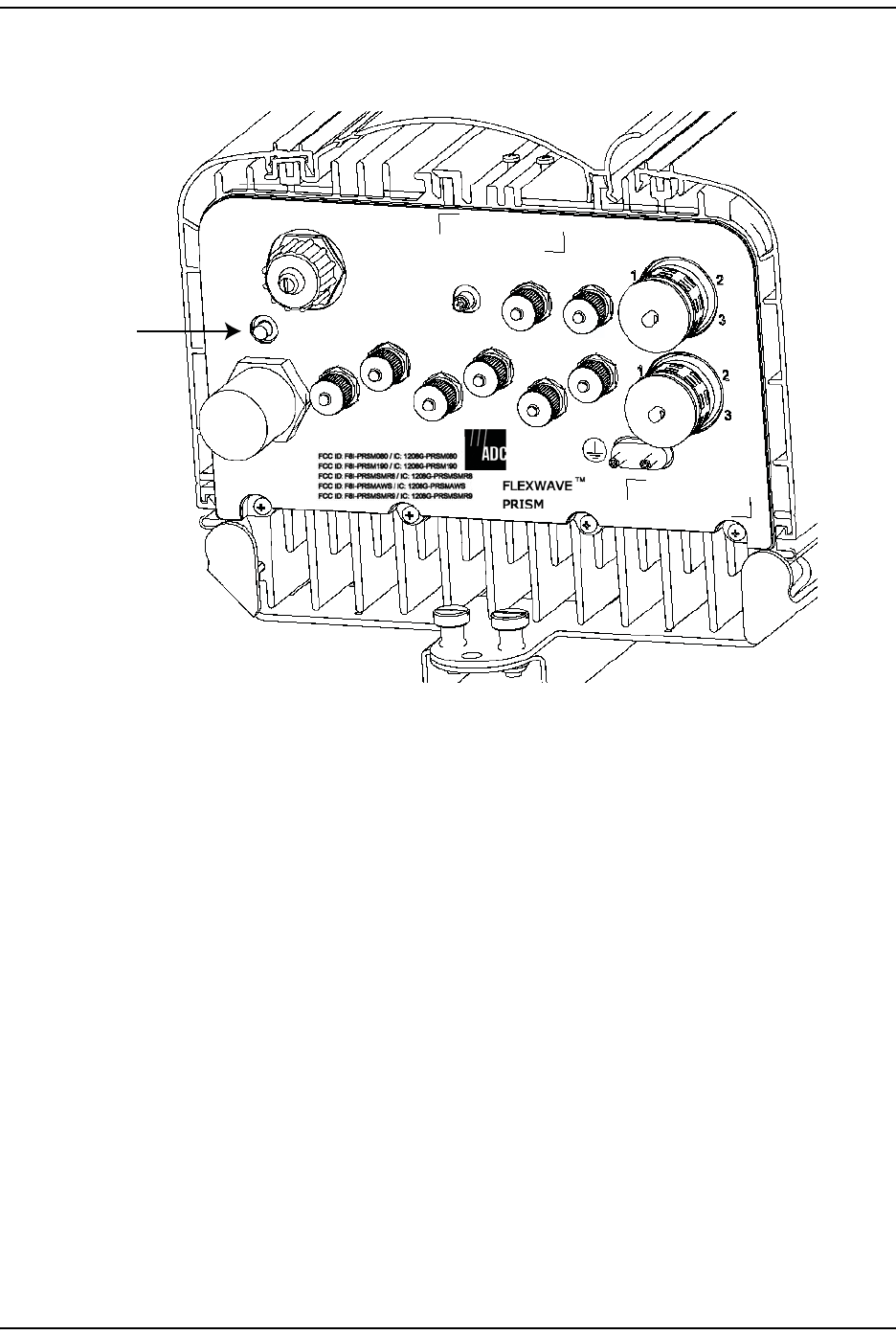
Prism Rem ot e Unit s
Page 18 FlexWave Prism Elem ent Managem ent Syst em 7.1 User Manual
© 2011 ADC Telecommunications, Inc ADCP-77-177 • I ssue 1 • July 2011
PRU Status LED (Bottom of PRU)
The PRU has a single red St at us LED that is located on the bot t om of the chassis.
At syst em st artup, the PRU Status LED is red t o indicat e that t he PRU is powering
up and t hat the SeRF processor does not yet cont rol the PRU.
Aft er st art up, if the PRU St at us LED is red, it indicates the presence of m aj or
alarm ( s) on t he PRU. The PRU St at us LED st ays red until all t he m aj or alarm
condit ions t hat exist on the PRU clear. (For inform at ion on alarm s t hat pert ain t o
the PRU, see “Troubleshooting Alarm s” on page 185.)
NETWORK
AUX.
MOD A
RX1
MOD A
TX0/RX0
FIBER 1
FIBER 2
MOD B
TX0/RX0
MOD B
RX1
MOD C
TX0/RX0
MOD D
TX0/RX0
MOD C
RX1
MOD D
RX1
POWER
100-240 VAC
50-60 Hz
16 AMPS
Status LED—Bottom of a PRU
Staus LED

Prism Syst em Overview
FlexWave Prism Elem ent Managem ent Syst em 7.1 User Manual Page 19
ADCP- 77- 1 77 • I ssue 1 • July 2011 © 2011 ADC Telecom m unications, I nc.
PRU Components
The PRU chassis is an out door- rat ed enclosure t hat com prises the following
com ponents:
•Power Supplies
•SeRF Module
•Fans
•I nterface connect ions as described in “ PRU Ports and Connectors ( Bott om of
PRU) ” on page 17
•External St at us LED (see “ PRU Stat us LED ( Bott om of PRU)” on page 18)
•Rem ote ( AC) power and RF Module (DC) power swit ches
PRUs ship wit h specified RF Modules pre- installed. The Prism RF Modules
com prise:
•DARTs
•Linear Power Am plifier (LPA)
•Duplexer wit h one or t wo Low Noise Am plifiers ( LNAs) and a Power Detector
( PD)
•Rem ote DART I nterface ( RDI ) Module
For furt her inform at ion on the RF Modules, see “RF Module Capabilit ies and GUI
Representation” on page 21.
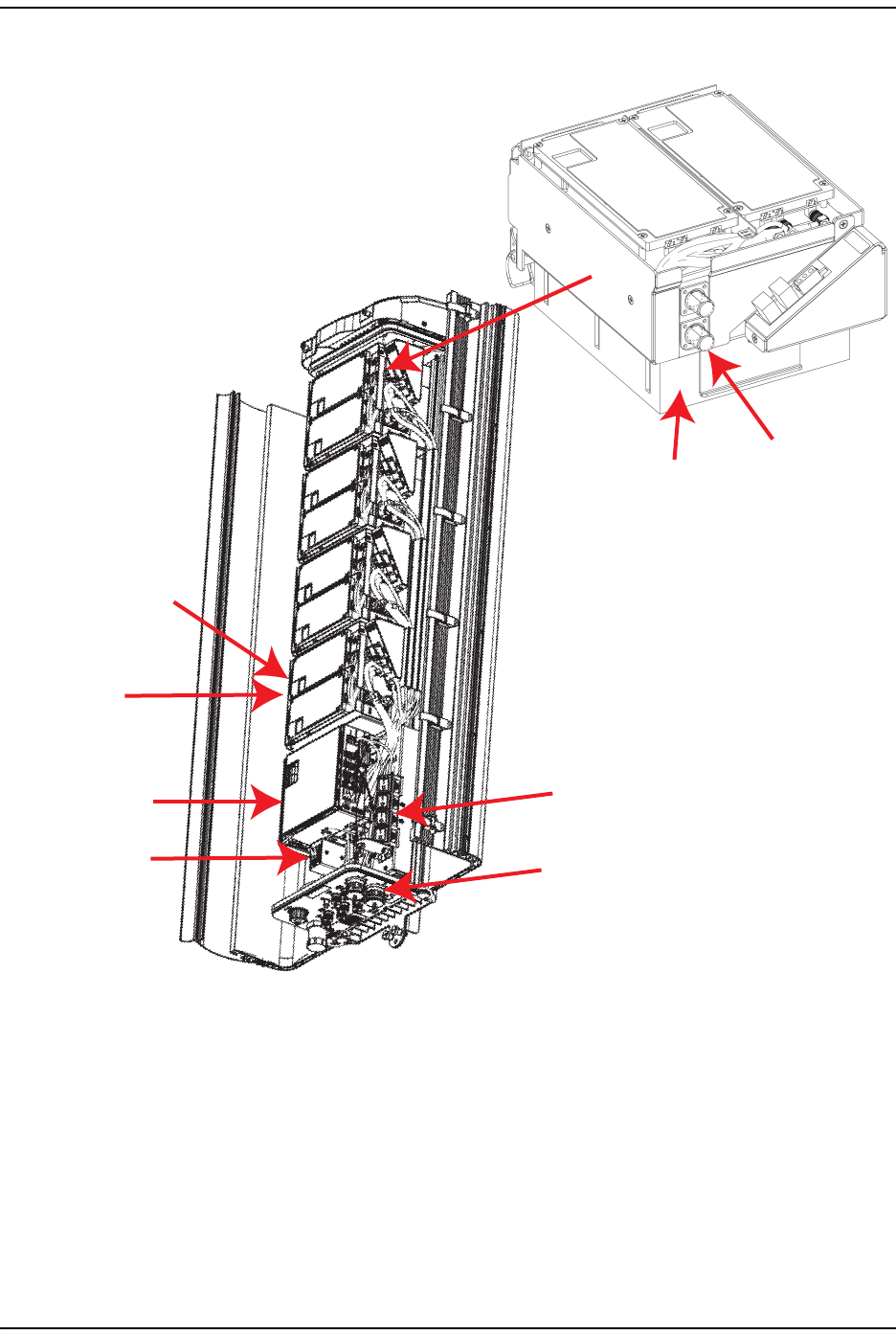
Prism Rem ot e Unit s
Page 20 FlexWave Prism Elem ent Managem ent Syst em 7.1 User Manual
© 2011 ADC Telecommunications, Inc ADCP-77-177 • I ssue 1 • July 2011
Figure 9 shows com ponent s within the Rem ot e Unit chassis.
Figure 9. Prism Remote Unit (PRU) Components
SeRF Module
AC Power switch
Linear
Power
Amplifier
Cable connectors and Status LED
DART card
(one or two on
each RF Module)
Remote DART Interface (RDI)
(one on each RF Module)
Duplexer
DC Power switches
for RF Modules
RF Module
(one of four in this
Quad-Band Prism)
77072-009

Prism Syst em Overview
FlexWave Prism Elem ent Managem ent Syst em 7.1 User Manual Page 21
ADCP- 77- 1 77 • I ssue 1 • July 2011 © 2011 ADC Telecom m unications, I nc.
RF Module Capabilities and GUI Representation
A PRU com prises from one t o four RF Module slots. Each RF Module can com prise
any of t he following DART com binations:
•one Classic DART or one Single SuperDART
•two Classic DARTs
•two Single SuperDARTs
•one Dual SuperDART.
A PRU can therefore com prise up t o eight single- slot DARTS or up to four Dual
SuperDARTs, dependent on t he Rem ot e chassis size and t he num ber of RF
Modules installed. To link the Remot e Unit DARTs to the DARTs in a Host Unit , the
DARTs m ust be t he sam e t ype ( such as, PCS to PCS).
NOTE: PRU RF Modules are not field serviceable. To replace a DART within a PRU, you must
replace the RF Module.
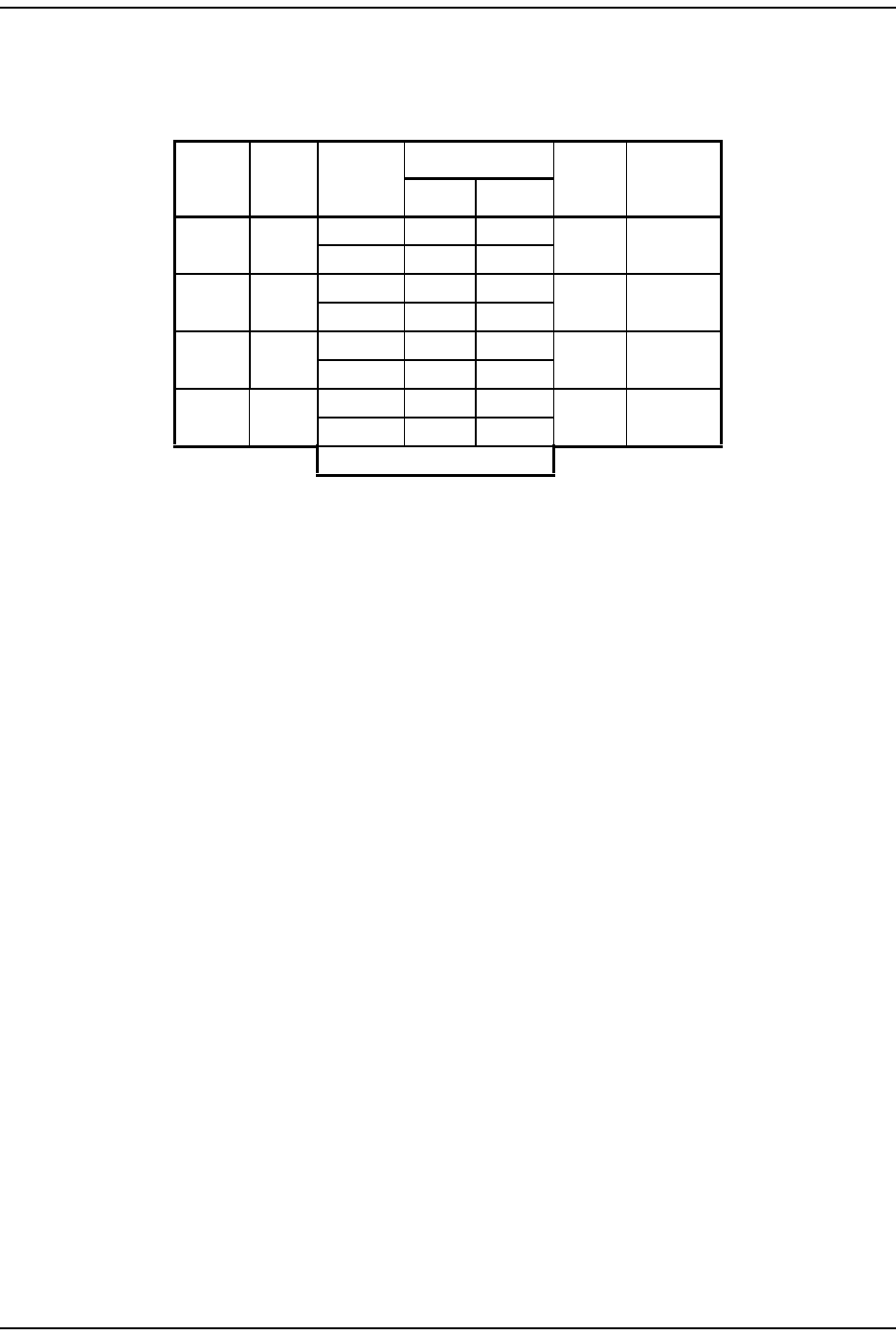
Prism Rem ot e Unit s
Page 22 FlexWave Prism Elem ent Managem ent Syst em 7.1 User Manual
© 2011 ADC Telecommunications, Inc ADCP-77-177 • I ssue 1 • July 2011
Table 1 and Figure 10 on page 23 describe how the EMS references the RF group
assignm ents and corresponding com ponents of each RF Module.
NOTE: In a dual-LPA system, the Configure Remote Forward Gain page shows two values for the
LPA status, one for each LPA. Changing the LPA Mode or resetting the LPA applies to both
LPAs at the same time. For further information on setting the LPA Mode, see “Configure
Remote Forward Gain” on page 91. For further information on resetting an LPA, see
“Resetting an LPA” on page 165.
Table 1. Remote RF Group Assignments (from Top/Down)
Physical
RF Slot
RF
Group
DART
Number
LNA Number LPA
Number
Power
Detector
Number
Primary Diversity
D D 8 8 4 4
7 7
C C 6 6 3 3
5 5
B B 4 4 2 2
3 3
A A 2 2 1 1
1 1
SeRF Board
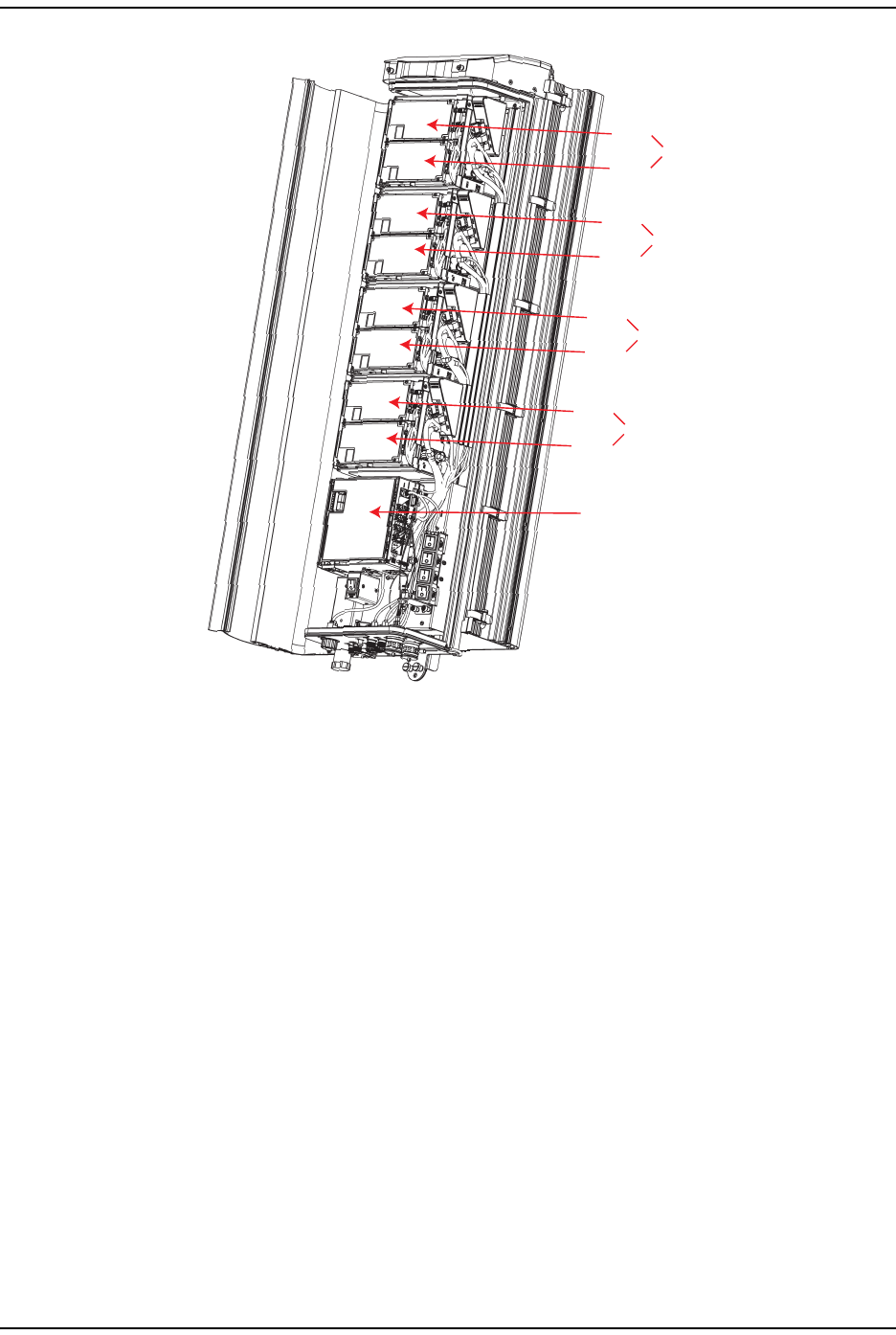
Prism Syst em Overview
FlexWave Prism Elem ent Managem ent Syst em 7.1 User Manual Page 23
ADCP- 77- 1 77 • I ssue 1 • July 2011 © 2011 ADC Telecom m unications, I nc.
Figure 10. DART RF Groups in a Prism Remote Unit
SeRF Module
77152-010
DART 7
DART 8
Group D
DART 5
DART 6
Group C
DART 3
DART 4
Group B
DART 1
DART 2
Group A

DART Modules
Page 24 FlexWave Prism Elem ent Managem ent Syst em 7.1 User Manual
© 2011 ADC Telecommunications, Inc ADCP-77-177 • I ssue 1 • July 2011
DART MODULES
DART Modules:
•am plify, down-convert, filter and digitize t he incom ing RF signal
•convert incom ing digital signal from the SeRF to analog, filter, am plify and
up- convert the frequency from I nterm ediate Frequency ( I F) to RF
•provide a bi- directional int erface between RF and the SeRF board ( via FPGA,
D/ A converter, and A/ D converter)
•provide uplink gain
•support Sim plex RF interfacing to/ from the BTS
•perform adj ustable delay processing.
Prism supports t he following types of DART Modules:
•Classic DARTs are 6-tim eslot DARTs t hat support up to 35 MHz cont iguous
bandwidth ( see Table 2) .
•Single SuperDARTs are 6- t im eslot DARTs that support t wo non- cont iguous
bands in the ent ire frequency range of t he DART, but cannot exceed 35 MHz
tot al RF bandwidth (see Table 3 on page 25) .
•Single SuperDARTs t hat can support 70/ 75 MHz bandwidt h in positions 1 or 3
when installed in a Host Unit I I that has both a SeRF I I Module and a Backplane
I I chassis installed. ( See Table 4 on page 25.)
•Dual SuperDARTs are 12-tim eslot DARTs that support up t o 70/ 75MHz wit h two
non-cont iguous bands ( see Table 4 on page 25) .
NOTE: Industry Canada PCS 20 dB nominal bandwidth is less than 61.5 MHz.
NOTE: Industry Canada AWS 20 dB nominal bandwidth is less than 47.2 MHz
Table 2. Single-Slot Classic DARTs
DART Name Maximum
Bandwidth
(MHz)
Number of
Fiber Slots
800 APAC iDEN Classic 19 3
800 SMR Classic 18 3
850 Classic 25 4
900 SMR Classic 5 1

Prism Syst em Overview
FlexWave Prism Elem ent Managem ent Syst em 7.1 User Manual Page 25
ADCP- 77- 1 77 • I ssue 1 • July 2011 © 2011 ADC Telecom m unications, I nc.
For further inform ation on DART Modules, see also “ Host DARTs” on page 26 and
“ RF Module Capabilit ies and GUI Representation” on page 21 (Rem ote RF Modules
cont ain Rem ote DARTs) .
Table 3. Single-Slot SuperDARTs (1)
DART Name Maximum
Frequency
Span (MHz)
Maximum
Bandwidth
(MHz)
Maximum
Fiber Slots
1800 SGL SuperDART 75 39 6
1900 PCS SGL SuperDART 70 39 6
2100 SGL AWS SuperDART 45 39 6
2100 SGL UMTS SuperDART 60 39 6
700 LowerABC SGL SuperDART 18 3
700 UpperC SGL SuperDART 10 2
900 EGSM SGL SuperDART 35 6
(1) When using a Host Unit II with both the SeRF II and System Board II
modules, the bandwidths and fiber slots shown are only available in Host
DART Slots 1 and 3 for Single-Slot SuperDARTs.
Table 4. Dual-Slot SuperDARTs
DART Name Maximum
Bandwidth
(MHz)
Number of
Fiber Slots
1800 DL SuperDART 75 12
1900 PCS DL SuperDART 70 12
2100 DL AWS SuperDART 45 8
2100 DL UMTS SuperDART 60 12
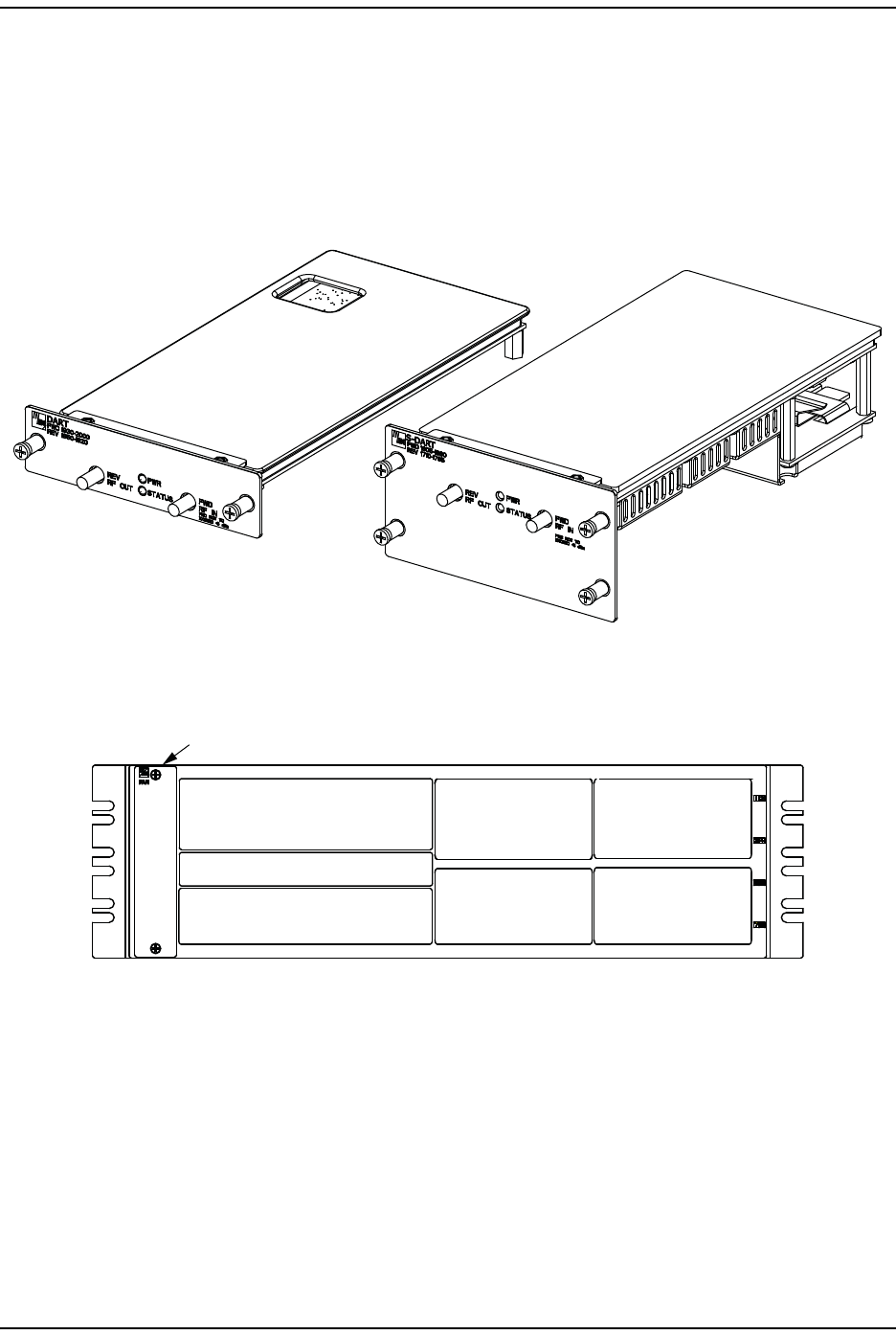
DART Modules
Page 26 FlexWave Prism Elem ent Managem ent Syst em 7.1 User Manual
© 2011 ADC Telecommunications, Inc ADCP-77-177 • I ssue 1 • July 2011
Host DARTs
The Host can support up to eight Classic DARTS and/ or Single SuperDARTs or up
to four Dual SuperDARTs. Figure 11 provides generic representations of Classic
DARTS or Single SuperDARTs and Dual SuperDARTs.
Figure 11. DART Modules
Figure 12 shows a Host t hat is fully loaded wit h Dual SuperDART Modules.
Figure 12. Host with Dual SuperDARTs
Generic representation of a
Classic DART or Single SuperDART
Generic representation of a
Dual SuperDART
77073-076
SeRF Card
System Card
Power Supply
Fan Assembly
Dual SuperDART
in Slots 1 and 3
Dual SuperDART
in Slots 2 And 4
Dual SuperDART
in Slots 5 And 7
Dual SuperDART
in Slots 6 And 8
77073-078
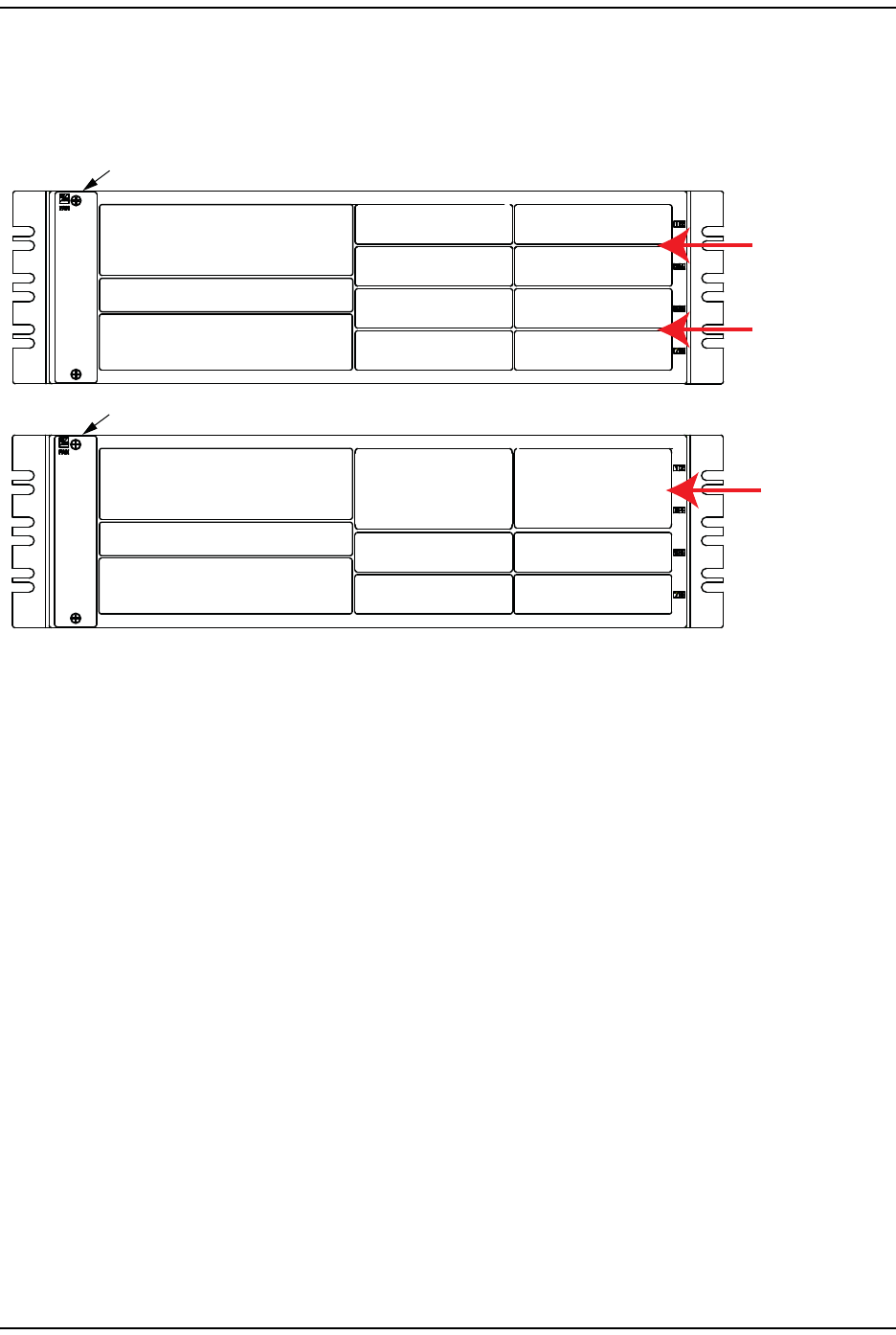
Prism Syst em Overview
FlexWave Prism Elem ent Managem ent Syst em 7.1 User Manual Page 27
ADCP- 77- 1 77 • I ssue 1 • July 2011 © 2011 ADC Telecom m unications, I nc.
Host DART Slots
Figure 13 shows the possible slot assignm ents for Single and Dual SuperDARTs,
and where slot - divider bars are located.
Figure 13. DART Slot Assignments in Host Chassis
Possible slot assignm ents for Single and Dual SuperDARTs are listed below.
•A Classic DART or Single SuperDART can be installed in each of t he eight slots
in the Host .
•Single- Slot SuperDARTs plugged into slots 1 or 3 of a Host t hat has both a SeRF
I I Module and a Backplane I I chassis installed can pass 12 fiber slots like a
dual- slot SuperDART.
•Dual SuperDARTs require t hat slot divider bars be rem oved as t heir size
requires two- slot com binations, which are available in t he following vertical
groupings:
–Slots 1 and 3
–Slots 2 and 4
–Slots 5 and 7
–Slots 6 and 8.
•Dual SuperDARTs cannot occupy hor izontal slot com binations:
–Slots 3 and 5
–Slots 4 and 6.
•Any com bination of DARTs m ay be installed.
SeRF Card
System Card
Power Supply
Single-Slot DART
in Slot 1
Single-Slot DART
in Slot 3
Single-Slot DART
in Slot 2
Single-Slot DART
in Slot 4
Single-Slot DART
in Slot 7
Single-Slot DART
in Slot 5
Single-Slot DART
in Slot 8
Single-Slot DART
in Slot 6
Fan Assembly
Divider bars between
Slots 1 and 3
and Slots 2 and 4
Divider bars between
Slots 5 and 7
and Slots 6 and 8
SeRF Card
System Card
Power Supply
Fan Assembly
77073-077
Dual-Slot DART
in Slots 1 and 3
Dual-Slot DART
in Slots 2 and 4
Single-Slot DART
in Slot 7
Single-Slot DART
in Slot 5
Single-Slot DART
in Slot 8
Single-Slot DART
in Slot 6
Divider bars between
Slots 1 and 3 and
Slots 2 and 4 removed
to accommodate
Dual-Slot DARTs
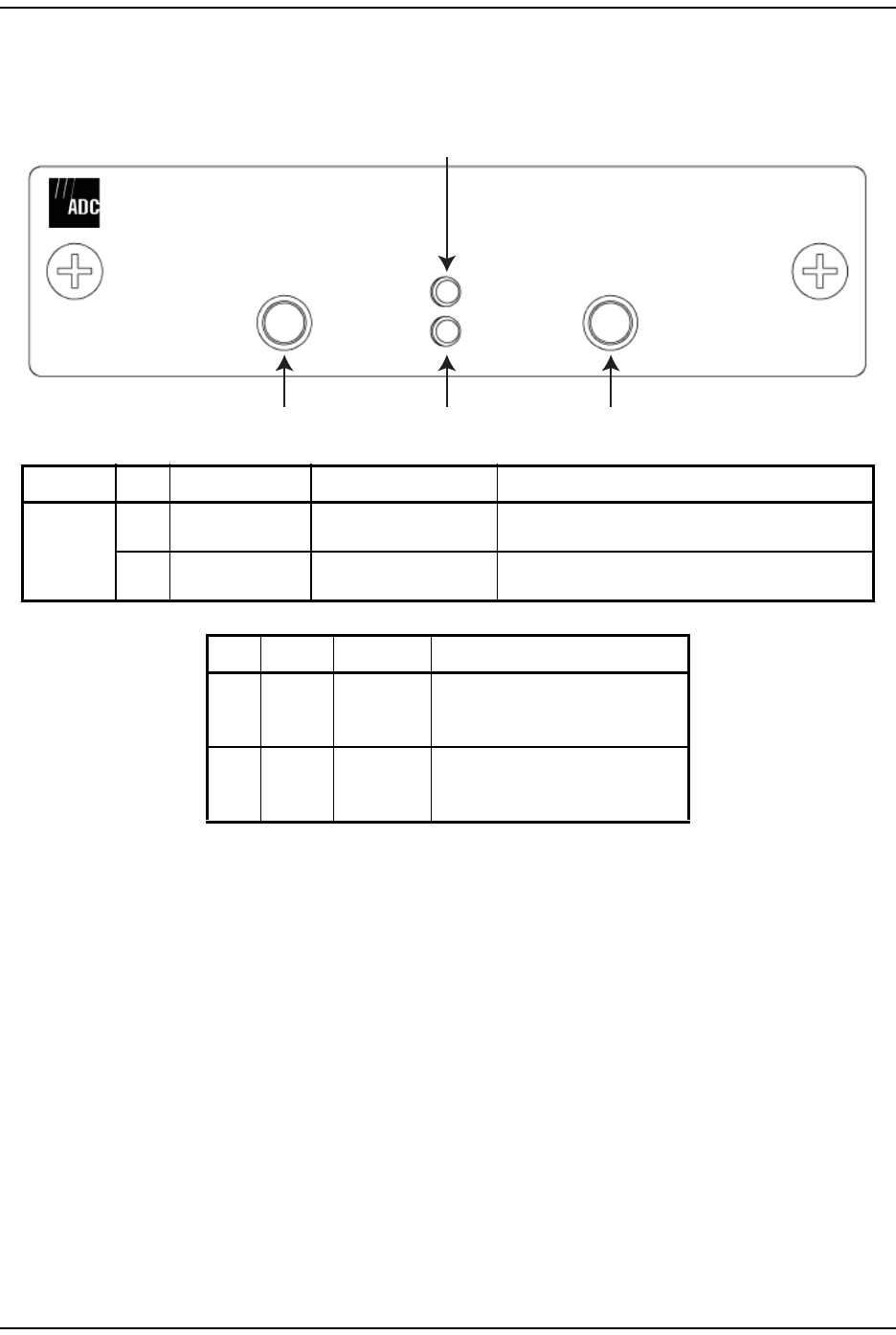
DART Modules
Page 28 FlexWave Prism Elem ent Managem ent Syst em 7.1 User Manual
© 2011 ADC Telecommunications, Inc ADCP-77-177 • I ssue 1 • July 2011
Host DART Connectors and LEDs
Only RF DART Modules can be inst alled in t he Host Unit .
DART Type Ref # Component Device Function
Host RF 2FWD RF IN QMA-Type female RF
coaxial connector
Input connection point for the forward path RF coaxial
cable to the BTS
4REV RF OUT QMA-Type female RF
coaxial connector
Output connection point for the reverse path RF
coaxial cable to the BTS
Ref # LED LED Color Description
1PWR • Green • Card is powered.
• Red • Problem with onboard power
• Off • No power present at card.
3STATUS •Green •OK
•Red •Major Alarm
• Yellow • Automatic Level Control active
1
4 3 2
Host RF DART
REV
RF OUT
FWD
RF IN
PWR
STATUS
S-DART
FWD 925-960
REV 880-915
FWD NOT TO
EXCEED +5 dBm

Prism Syst em Overview
FlexWave Prism Elem ent Managem ent Syst em 7.1 User Manual Page 29
ADCP- 77- 1 77 • I ssue 1 • July 2011 © 2011 ADC Telecom m unications, I nc.
Serialized RF (SeRF) Digital Protocol
The SeRF ( Serialized RF) digital protocol consist s of digit ized RF, Fast Et hernet,
and Host to Rem ot e com m unicat ion and m anagem ent. The prot ocol provides you
wit h full access to the 100BASE- T ( Ethernet) connect ion between the Host and
each Rem ote, and the abilit y t o provision t he RF spect rum of t he DARTs. The
digit ized RF portion of t he SeRF protocol is divided into 12 t im eslots, wit h each
tim eslot representing roughly 5 MHz of digit ized RF spectrum . Ut ilizing the full 12
tim eslots yields between 60 and 75 MHz of tot al digitized RF on each SeRF Small
Form - Fact or Pluggable (SFP) laser connect ion ( single fiber pair) .
The available RF bandwidt h per tim eslot is shown in Table 5.
For exam ple, a user who wishes t o t ransport PCS A block, Cellular A, and AWS B
block, t he system would require the following:
PCS A 15MHz, 3 t im eslots
Cellular A 10MHz, 2 t im eslots
AWS B 10MHz, 2 tim eslots
__________________________
Tot al = 35MHz, 7 tim eslots
Each fiber pair supports 12 tim eslot s, or up t o 75 MHz of bandwidth. Table 5 shows
the m axim um bandwidt h versus t he num ber of t im eslots.
I f m ore than 70 MHz is required per Rem ote, up t o t hree additional fiber pairs can
be brought to the Rem ote to get up t o up to 280MHz per Remot e (or 300MHz if all
four are GSM- 1800).
Table 5. Available RF Bandwidth
Number of
Timeslots
Maximum Contiguous
RF Bandwidth (MHz)
Classic
DARTs
Single and Dual
SuperDARTs
1 5 6
212.5 12
3 20 18
4 25 25
6 35 39
8--- 45
12 --- 60-75
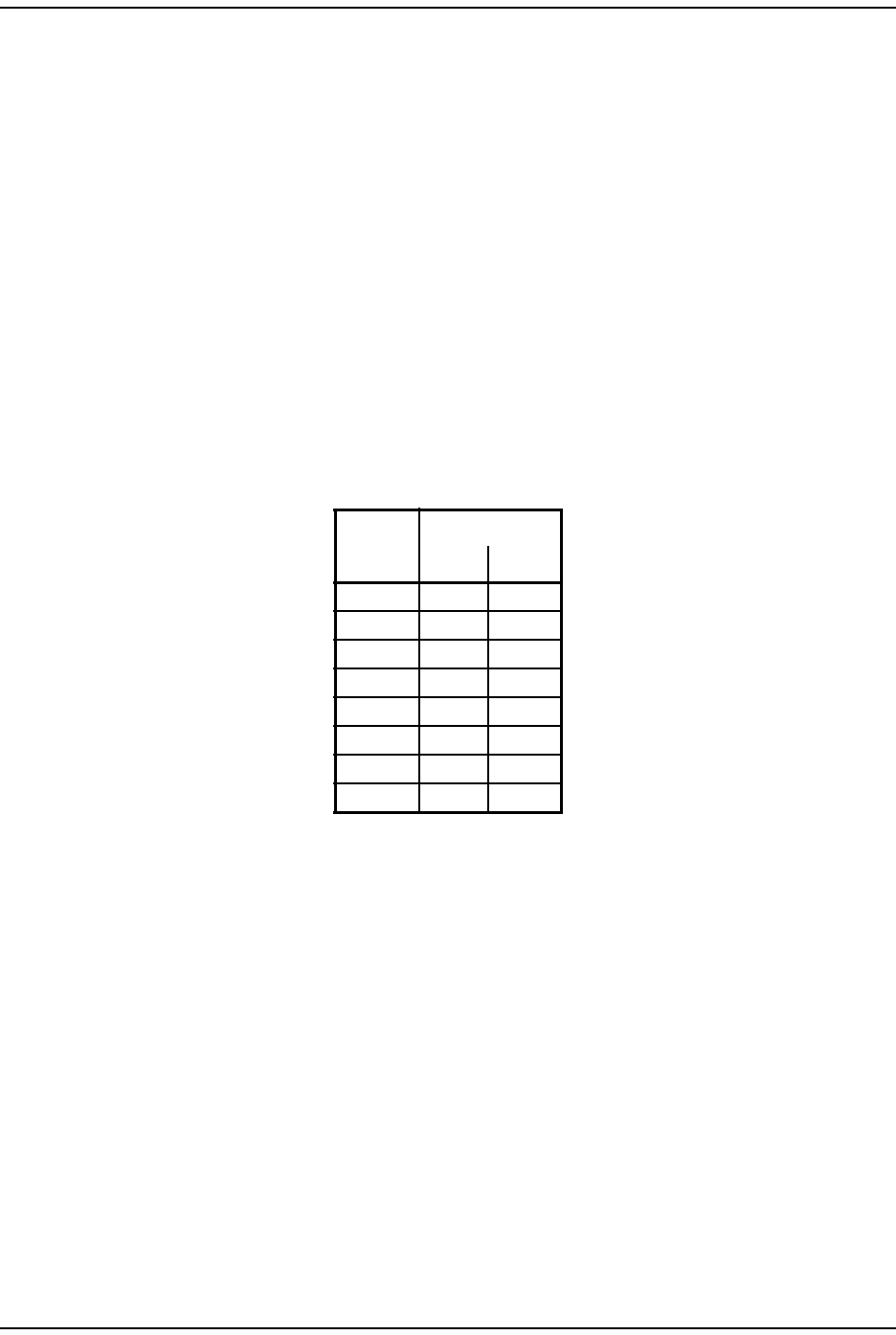
DART Modules
Page 30 FlexWave Prism Elem ent Managem ent Syst em 7.1 User Manual
© 2011 ADC Telecommunications, Inc ADCP-77-177 • I ssue 1 • July 2011
Simulcast Groups
Sim ulcast com bining occurs when m ore t han one Rem ot e DART is linked t o t he
sam e Host DART. The gains of the reverse signals are reduced before sum m at ion
to prevent over-flow when the digit al signals are added toget her. This sim ulcast
gain reduct ion is accom plished as a function of the num ber of Rem ot e DARTs
linked t o the Host DART ( N) and the select ed Reverse Gain Mode:
•Mode 1 (Noise Floor Matching)—uses an algorit hm t hat norm alizes t he noise floor of
all Rem ote Unit s.
•Mode 2 (Legacy Prism/URH)—reduces the gain by 20* log10( N).
•Mode 1 (Noise Floor Matching) uses an algorit hm that norm alizes the noise floor
of all Rem ot e Unit s.
•Mode 2 (Legacy Prism/URH)—reduces the gain by 20* log10(N) .
Table 6 illustrates gain reduction for Mode 1 and Mode 2.
Sim ulcast groups are rest ricted t o using the sam e tim eslots on the fibers t o each
Rem ote. For exam ple, if t he first link established in a sim ulcast group is using
tim eslots 1- 3 on a fiber for the PCS A passband, t im eslots 1-3 m ust be used for
that passband on each of the ot her Rem ot es in the sim ulcast group. I f tim eslots
1-3 are not available on a Rem ot e's fiber, t he Rem ote cannot be added t o t he
sim ulcast group.
To m inim ize t im eslot conflicts, sim ulcast groups should be configured before other
passbands. I f a conflict occurs while at t em pt ing to link a DART, an error m essage
displays indicat ing t hat the DART linking failed. The DART using t he conflicting
tim eslots m ust be unlinked to allow the DART in the sim ulcast group to be linked.
Table 6. Reverse Gain Mode and Gain Reduction
# Remote
DARTs
Reduction (dB)
Mode 1 Mode 2
1 0 0
23.0 6.0
34.7 9.5
46.0 12.0
57.0 14.0
67.8 15.6
78.3 16.9
89.0 18.0

Prism Syst em Overview
FlexWave Prism Elem ent Managem ent Syst em 7.1 User Manual Page 31
ADCP- 77- 1 77 • I ssue 1 • July 2011 © 2011 ADC Telecom m unications, I nc.
Use of Multi Fibers
The EMS provides t he ability to install “ m ulti fibers” bet ween a Host and Rem ote.
This m eans that, in addition t o the m inim um single fiber pair ( RX and TX) in t he
Host to Rem ote connection, one or m ore additional fiber pairs are inst alled. This
is done to increase the bandwidt h or num ber of t im eslots between t he Host and
Rem ote.
Each fiber pair can handle approxim at ely 75 MHz of RF bandwidth and each fiber
is capable of supporting 12 tim eslots, as described in “ DART Modules” on page 24.
When a Host DART is linked t o a Rem ote DART in a m ulti- fibers configuration, the
EMS uses t he first fiber ( in num erical order) on which the required num ber of
tim eslots is available for the passband being linked. The EMS will not divide up t he
tim eslots between t wo fibers. So, for exam ple, if t he passband requires eight
tim eslots, and only six tim eslots are available on t he first fiber, the EMS will bypass
the first fiber and assign all eight t im eslots t o t he second fiber, leaving four
tim eslots unused on the second fiber.
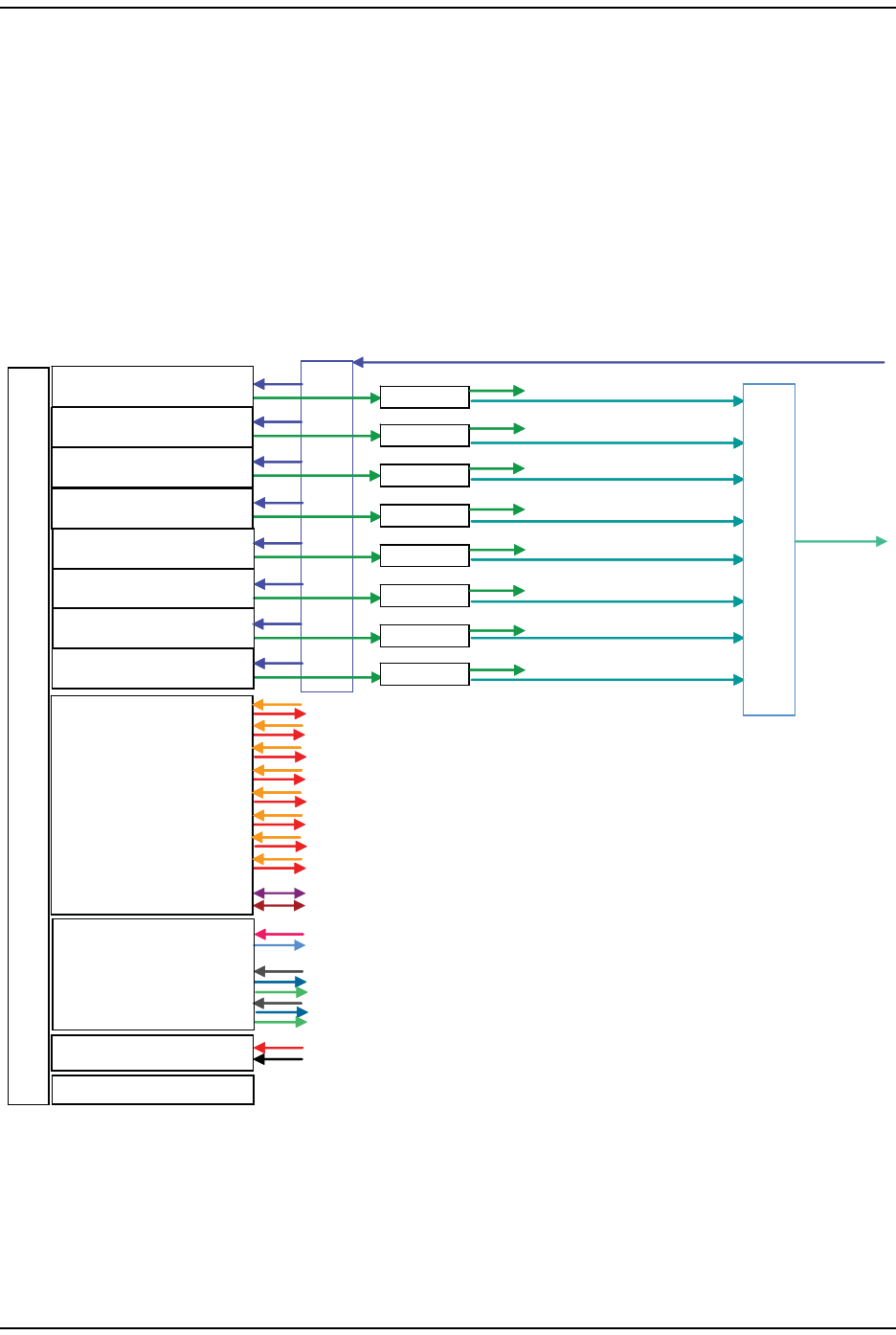
DART Modules
Page 32 FlexWave Prism Elem ent Managem ent Syst em 7.1 User Manual
© 2011 ADC Telecommunications, Inc ADCP-77-177 • I ssue 1 • July 2011
E911 Support
The DART type determ ines the m axim um num ber of links, where there can be up
up to 8 Classic DARTs or Single SuperDARTs that support 35MHz each, or up to 4
Dual SuperDARTs that support up to 75MHz each.
E911 support m ay be achieved by using a configuration sim ilar to t he one shown
in Figure 14. Remot e sim ulcast ing in t his configuration requires analog splitt ing
and com bining to and from the individual Host DARTs. External analog
split t ing/ com bining ensures that the E911 system receives uplink signals from
each Rem ote location before t hey are com bined wit h uplink signals from the ot her
Rem otes in the sim ulcast.
Figure 14. 8:1 Analog Simulcast U-TDoA E911 Support Diagram
NOTE: When external E911 equipment is required, simulcasting must be accomplished via
external RF splitting and combining. The DARTs will then be in a point-to-point
configuration, as opposed to point-to-multipoint.
2:1 Splitter
2:1 Splitter
2:1 Splitter
2:1 Splitter
2:1 Splitter
2:1 Splitter
2:1 Splitter
2:1 Splitter
8:18:1
DART Board (1)
DART Board (2)
DART Board (3)
DART Board (4)
DART Board (5)
DART Board (6)
DART Board (7)
DART Board (8)
SeRF Board
System Board
Power Board
Fan Assembly
2:1 Splitter
2:1 Splitter
2:1 Splitter
2:1 Splitter
2:1 Splitter
2:1 Splitter
2:1 Splitter
2:1 Splitter
E911
E911
E911
E911
E911
E911
E911
E911
B
A
C
K
P
L
A
N
E
B
O
A
R
D
BTS REV
BTS FWD
77152-003

Prism Syst em Overview
FlexWave Prism Elem ent Managem ent Syst em 7.1 User Manual Page 33
ADCP- 77- 1 77 • I ssue 1 • July 2011 © 2011 ADC Telecom m unications, I nc.
PRISM SYSTEM SPECIFICATIONS
Table 7. RF and Optical Specifications
Parameter Specification aRemarks
RF Specifications
Supported Frequency Blocks 1-8 per Host Unit
Bandwidth 1.5 to 75 MHz non-contiguous
Supported Frequency Bands • 850 Cellular
• 1900 PCS
• 700 LowerABC
• 700 UpperC
• 2100 AWS
• 800/900 E-SMR
• 900 GSM
• 1800 DCS
• 2100 UMTS
Propagation Delay
System Delay <12 microseconds
Delay Management Digital Manual or Automatic
Reverse Path Noise Figure Noise Figure Input
Typical Maximum IP3
Normal Mode 5 dB 6 dB >-8 dBm
High Gain Mode - Classic DARTs 4 dB 5 dB >-12 dBm
High Gain Mode - SuperDARTs 3 dB 4 dB >-14 dBm
System Gain Standard High Gain
Mode Mode
Classic DARTs 36 dB 38 dB
SuperDARTs 30 dB 36 dB
Optical Budget for optical BER of 10–6 Standard Optional
26 dB 13 dB
Digital Transport Rate 3.072 Gbps
Optical power levels Minimum Maximum
Intermediate Range Launch Power -5 dBm 1 dBm
Intermediate Range Receive Power -18 dBm 1 dBm
Long Range Launch Power -2 dBm 3 dBm
Long Range Receive Power -27 dBm -9 dBm
Transceiver Wavelengths For information on transceiver
transmissions with a CWDM, see the
ADC FlexWave Prism Coarse
Wavelength Division Multiplexer User
Manual (ADCP-75-353).
Transmits 1550 nm signal
Receives 1550 or 1310 nm signal

Prism Syst em Specifications
Page 34 FlexWave Prism Elem ent Managem ent Syst em 7.1 User Manual
© 2011 ADC Telecommunications, Inc ADCP-77-177 • I ssue 1 • July 2011
Optical - Host II and Remote Units
Fiber type 9/125, single-mode
Number of fibers required up to 75 MHz RF per fiber pair
(or fiber if using WDM).
Assumes RF bandwidth does not
exceed 3 Gbps data rate capacity of
the fiber.
Optical - WDM
WDM Passband 1310 nm ± 20 nm
1550 nm ± 20 nm
Forward path insertion loss Host WDM Remote WDM
0.7 dB 0.3 dB
Does not include connector loss
Reverse path insertion loss Host WDM Remote WDM
0.3 dB 0.7 dB
Does not include connector loss
Isolation > 30 dB minimum
Return loss (Reflectance) < –50 dB All input ports
aAll specifications apply after a five minute warm-up period.
Table 8. Host Unit II Technical Specifications
Parameter Specification Notes
Power
DC Power ±21 – ±60 Vdc floating
Power consumption Maximum: 320 Watts
Nominal: 202 Watts
Current rating for maximum system
(eight DARTs and eight SFPs)
7.5 Amps @ 48Vdc
15 Amps @ 24Vdc
Connectors and Ports
RF coaxial cable connectors 50 ohm QMA – type (female) 50 ohms input/output impedance
Network and Craft connectors RJ–45 jack
External alarm connector Screw-type terminals Normally Open (NO), Common (COM), and
Normally Closed (NC) relay contacts
Optical ports SFP transceivers Industry standard LC (UPC); Host and WDM
Physical Specifications
Dimensions
Inches
Millimeters
Height x Width x Depth
5.17 17.26 9.5
131.3 438.4 241.3
Width dimension does not include the
mounting brackets for 19- or 23-inch racks.
Mounting 19- or 23-inch rack EIA or WECO
Weight 20 lbs. (9.1 kg)
Environmental Environmentally controlled outdoor cabinet
Weather resistance Indoor installation only
Operating temperature 0º to 50º C (32º to 122ºF)
Storage temperature –40º to 70º C (–40º to 158ºF)
Humidity 10% to 90% No condensation
Reliability at 25ºC MTBF 200,000 hours Excluding fans
Table 7. RF and Optical Specifications (Cont.)
Parameter Specification aRemarks

Prism Syst em Overview
FlexWave Prism Elem ent Managem ent Syst em 7.1 User Manual Page 35
ADCP- 77- 1 77 • I ssue 1 • July 2011 © 2011 ADC Telecom m unications, I nc.
Table 9. Remote Unit Technical Specifications
Parameter Specification Remarks
Enclosure dimensions Height x Width x Depth
Single-Band Inches
Centimeters
25.2 12.2 11.2
64 x 30.99 x 28.45
• Dimension for width includes the
mounting brackets.
• To have adequate clearance to open
the Remote chassis door, allow a
minimum of 7 inches at the left, right
and front of each Remote.
Dual-Band Inches
Centimeters
33.2 12.2 11.2
84.3 x 30.99 x 28.45
Tri-Band Inches
Centimeters
41.2 12.2 11.2
104.6 x 30.99 x 28.45
Quad-Band Inches
Centimeters
52.4 12.2 11.2
133.10 x 30.99 x 28.45
Mounting Wall, Pole, Inside Pole, and Vault
Weight Unpopulated Populated • “Unpopulated” weight includes the
Solar shields, which are always
present.
• “Populated” weight is the weight of the
chassis that has the SeRF Module and
RF Modules installed.
Single-Band Pounds
Kilograms
65 83
29 38
Dual-Band Pounds
Kilograms
81 117
37 53 kg
Tri-Band Pounds
Kilograms
97 151
44 68 kg
Quad-Band Pounds
Kilograms
116 188
53 85 kg
Outside Ambient
Temperature Rating -40° C to +50° C (-40º F to +122º F)
Storage Temperature -40° C to +70° C (-40º F to +158º F)
Humidity 10% to 90% non-condensing
Weather Resistance IP-65 Indoor or outdoor installation
Lightning Protection 20kA IEC 1000-45 8/30 ìs Waveform Provided by external lightning protector,
which is an accessory.
Cooling Fan, IP-55
Operating Voltage Range 10 - 28 Vdc
Operating Temperature Range -10 - 70°C (14°F - 158°F)
Storage Temperature Range -40 - 70°C (-40°F - 158°F)
Connectors
Network port RJ-45 female connector
AC power connector Sealed 3-pin Connection point for the AC power cord
Antenna cable connector 50 ohm N-Type (female) 50 ohms input/output impedance
Voltage input 100 to 240 VAC, 50 to 60 Hz Operating range 90 to 265 VAC
Current rating 15 AMPS
Encapsulation PBT Encapsulated Motor and Control PCB
Bearings Abec 3, double shielded, chrome ball bearings
Continuous Duty Life-Cycle 50,000 hours at 25°C (77°F)
Safety UL/C-UL File E137077, TUV

Prism Syst em Specifications
Page 36 FlexWave Prism Elem ent Managem ent Syst em 7.1 User Manual
© 2011 ADC Telecommunications, Inc ADCP-77-177 • I ssue 1 • July 2011
I ntent ionally Blank Page

FlexWave Prism Elem ent Managem ent Syst em 7.1 User Manual Page 37
ADCP- 77- 1 77 • I ssue 1 • July 2011 © 2011 ADC Telecom m unications, I nc.
PART I I
SYSTEM SETUP

Page 38 FlexWave Prism Elem ent Managem ent Syst em 7.1 User Manual
© 2011 ADC Telecommunications, Inc ADCP-77-177 • I ssue 1 • July 2011
I ntent ionally Blank Page

FlexWave Prism Elem ent Managem ent Syst em 7.1 User Manual Page 39
ADCP- 77- 1 77 • I ssue 1 • July 2011 © 2011 ADC Telecommunications, Inc.
USING THE PRISM EMS
How t o Use the EMS Graphical User I nterface ............................................................................40
Syst em Tree ....................................................................................................................41
Syst em Tree I cons............................................................................................................42
EMS View Fram e Elem ent s................................................................................................. 42
Unit I dentification .............................................................................................................43
Viewing Param eters and Alarm s .........................................................................................44
Alarm Color Codes ......................................................................................................44
Viewing Alarm Details..................................................................................................45
Sorting Tables..................................................................................................................46
Following t he Procedures in t his Docum ent ................................................................................ 47
St arting a Procedure ......................................................................................................... 47
Modifying Param eters........................................................................................................ 47
Selecting Menu I tem s........................................................................................................ 48
Using t he Help Em bedded in the GUI ........................................................................................49
Accessing Help .................................................................................................................49
Navigating Help................................................................................................................50
Using t he Cont ent s Tab................................................................................................50
Using t he Orientation Links and Butt ons......................................................................... 51
Using t he I ndex Tab ....................................................................................................52
Using t he Search Tab ..................................................................................................53
This section provides a basic descript ion of the Prism Elem ent Managem ent
Syst em ( EMS) .
Topics Page
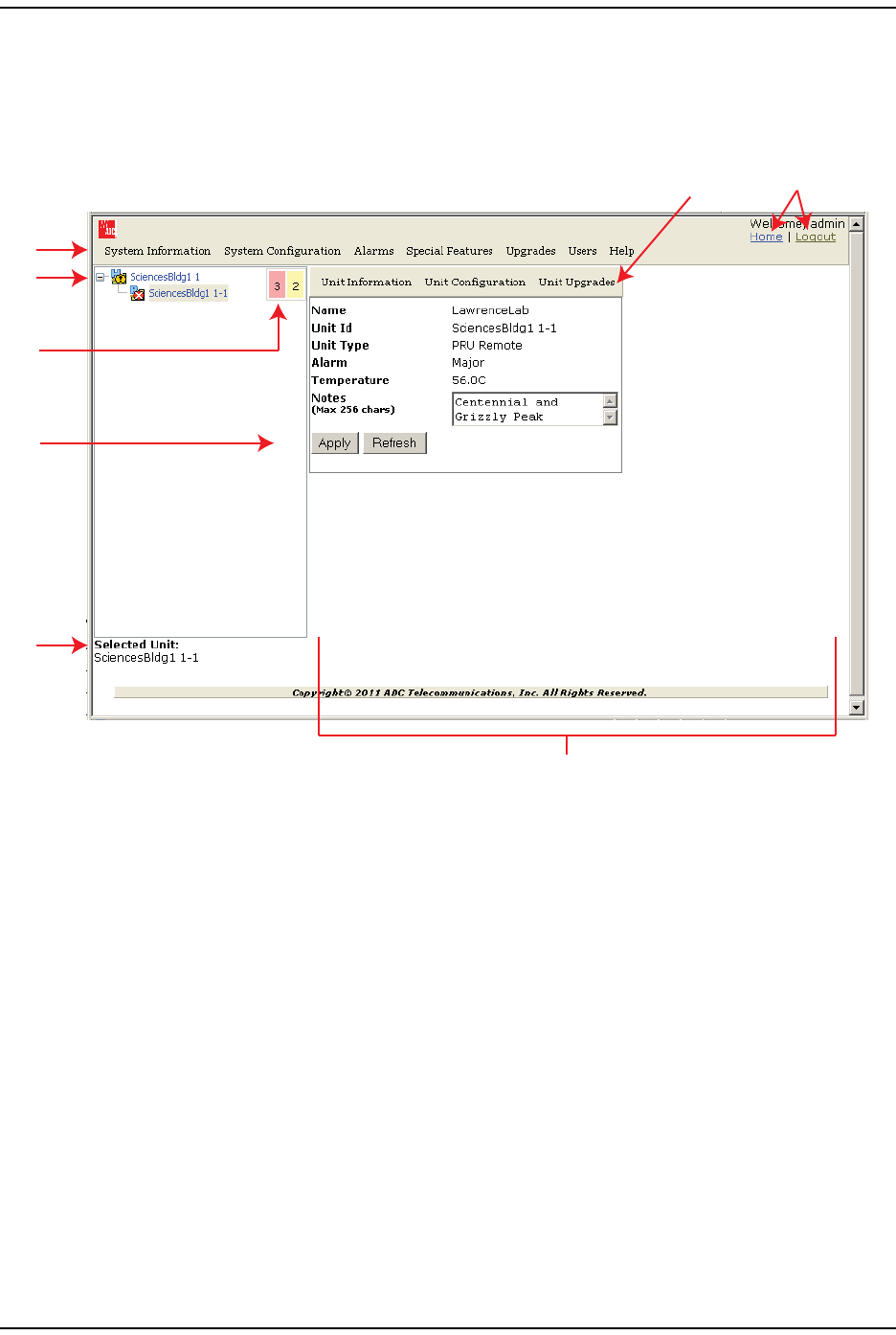
How t o Use t he EMS Graphical User I nt erface
Page 40 FlexWave Prism Elem ent Managem ent Syst em 7.1 User Manual
© 2011 ADC Telecommunications, Inc ADCP-77-177 • I ssue 1 • July 2011
HOW TO USE THE EMS GRAPHICAL USER INTERFACE
You use a web browser to access the EMS Graphical User I nterface (GUI ) shown
in Figure 15 and described in Table 10.
Figure 15. EMS Graphical User Interface
1
3
2
4
5
87
6
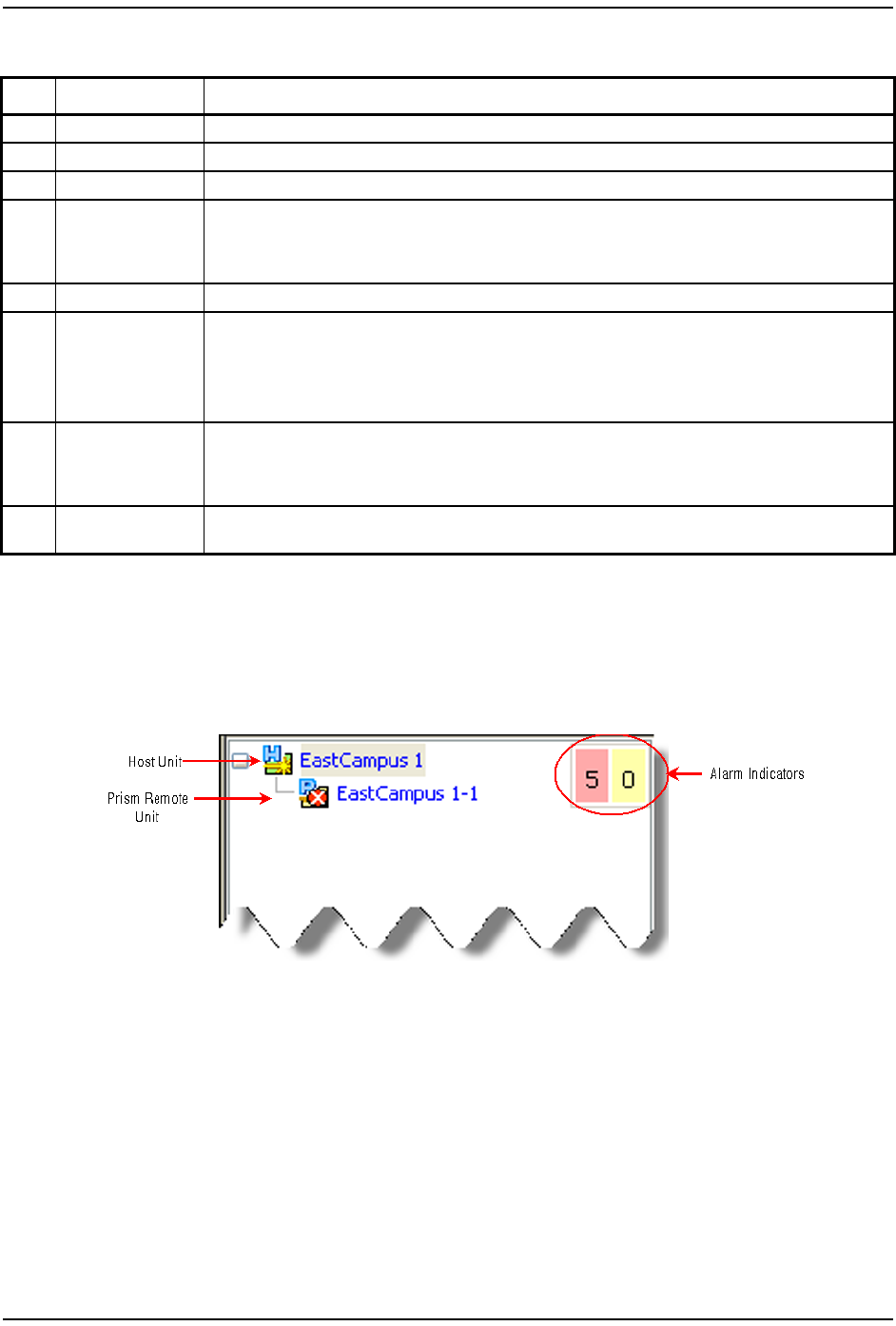
Using t he Prism EMS
FlexWave Prism Elem ent Managem ent Syst em 7.1 User Manual Page 41
ADCP- 77- 1 77 • I ssue 1 • July 2011 © 2011 ADC Telecom m unications, I nc.
System Tree
The Syst em Tree displays a Prism syst em as device icons wit hin a hierarchical tree
that is autom at ically organized by Unit I D:
You click on a node t o navigat e t o a web page wit hin the EMS View Fram e t hat
corresponds to the select ed unit .
The Alarm indicators in t he upper-right corner of the Syst em Tree let you know
how m any active alarm s t here are, and at what severity level. I n the preceding
figure, the Alarm indicators show:
•5 act ive Maj or alarm s, as indicat ed by t he red box
•0 act ive Minor alarm s, as indicat ed by the yellow box.
Table 10. GUI Components
ID # Component Description
1System Menu bar Provides access to menus that allow you to configure or view system settings and alarms.
2System Tree See “System Tree” on page 41.
3Alarm indicators Provides a visual view of the number of active alarms and their severity level.
4Operational buttons
Execute the command for which the button is labeled:
•Apply—Applies your configuration changes without closing the dialog.
•Refresh—Updates status information to reflect current conditions.
5Unit Identifier Identifies which system component is selected in the System Tree.
6EMS View Frame
Provides the work space in which you access a Prism EMS web page specific to a unit or function.
NOTE: You can use your keyboard to navigate through the EMS pages:
•SPACE key on the keyboard scrolls down by a page
•SHIFT+SCROLL scrolls up one page.
7Orientation links
Provides links that allow you to navigate within the GUI:
•Home—returns you to the Home page
•Logout—logs you out of the EMS.
8Unit Menu bar Provides access to menus that allow you to configure or view settings and alarms that pertain to the
unit that is actively selected in the System Tree.
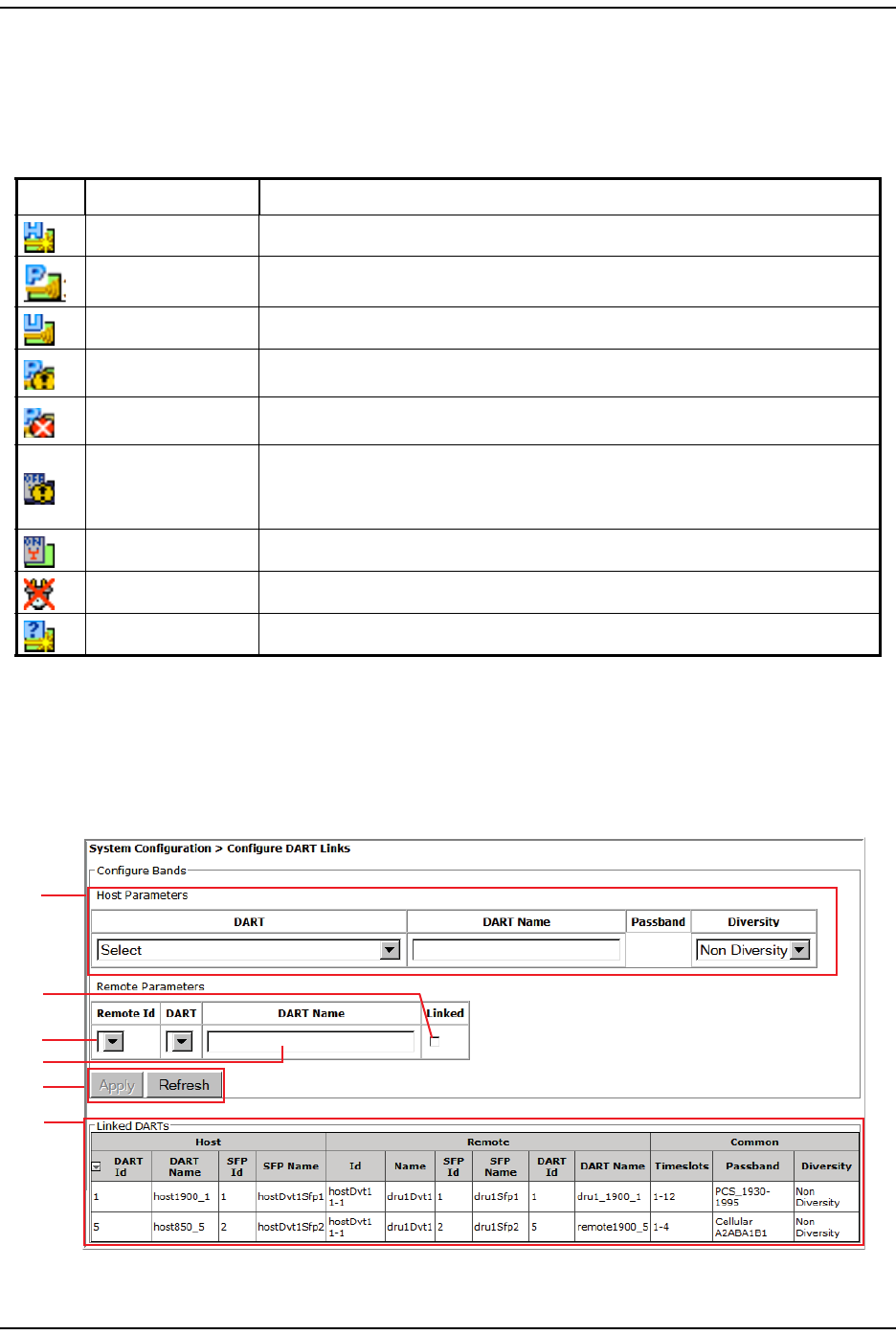
How t o Use t he EMS Graphical User I nt erface
Page 42 FlexWave Prism Elem ent Managem ent Syst em 7.1 User Manual
© 2011 ADC Telecommunications, Inc ADCP-77-177 • I ssue 1 • July 2011
System Tree Icons
Table 11 describes t he icons used in t he Syst em Tree.
EMS View Frame Elements
Figure 16 and Table 12 describe the different elem ents found wit hin the EMS View
Fram e.
Figure 16. Elements within a View Frame
Table 11. System Tree Icons
Icon Unit/State Description
Host Host Unit; normal status
PRU Prism Remote Unit; normal status
URU Universal Radio Head Remote Unit; normal status
Minor Alarm State A yellow caution overlay on a unit icon indicates that the unit has an active Minor alarm. If
the icon is blinking, the alarm is unacknowledged.
Major Alarm State A red danger overlay on a unit icon indicates that the unit has an active Major alarm. If the
icon is blinking, the alarm is unacknowledged.
Contact Alarm State
Indicates a Contact Alarm state:
• Static—the alarm is acknowledged.
• Blinking—the alarm is unacknowledged.
No Contact Alarm State Indicates a No Contact Alarm state.
Disconnect Indicates that the unit is disconnected. Applicable only to PRUs and URUs.
Unknown Unit Identifies a unit that the EMS has found but cannot recognize.
1
2
3
4
5
6
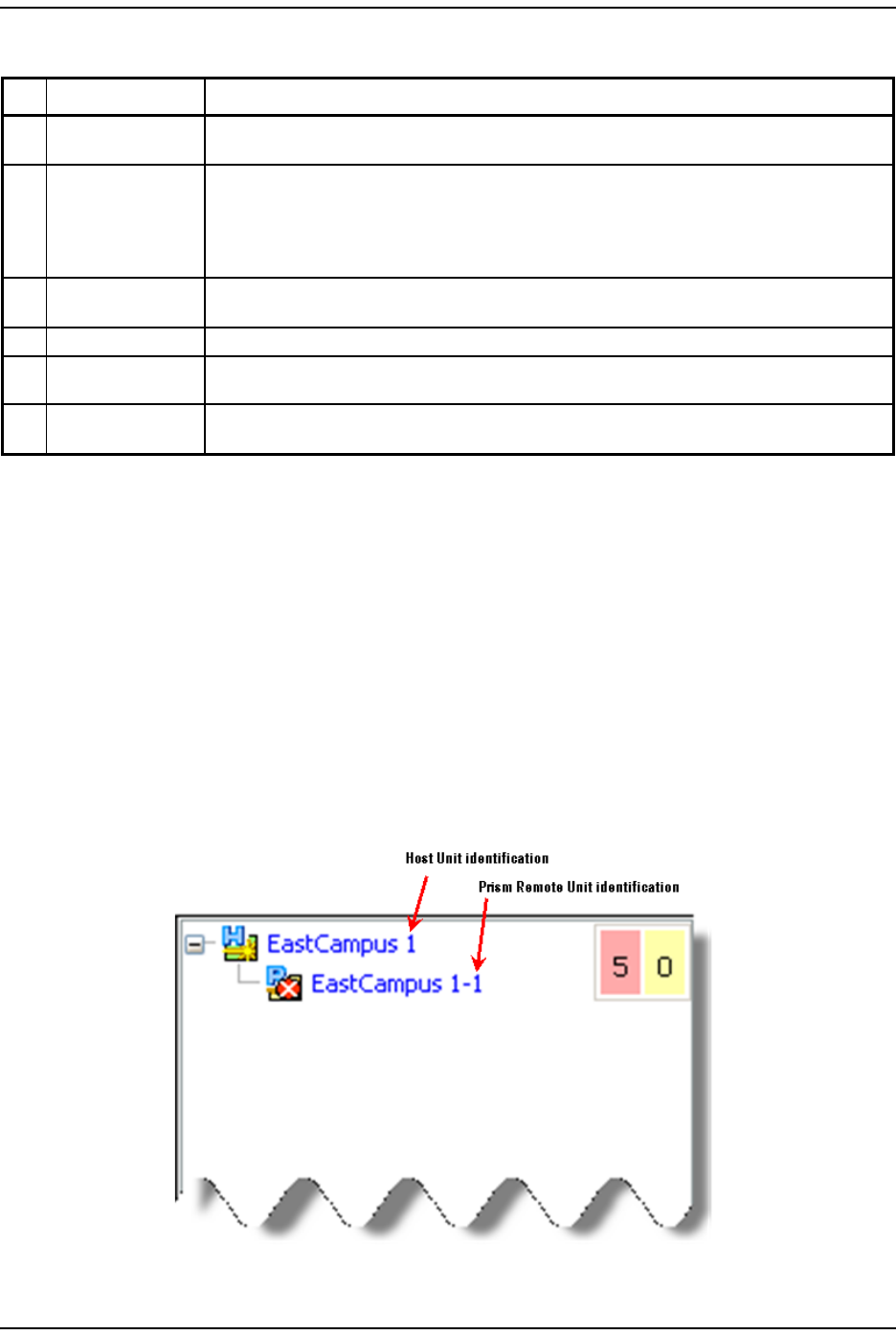
Using t he Prism EMS
FlexWave Prism Elem ent Managem ent Syst em 7.1 User Manual Page 43
ADCP- 77- 1 77 • I ssue 1 • July 2011 © 2011 ADC Telecom m unications, I nc.
NOTE: The View Frame is designed to update its contents within a web browser approximately
every 20 seconds.
Unit Identification
Figure 17 shows the Unit I D in t he System Tree. The Unit I D is t he hostnam e
( user- defined label) plus t he layer address. The layered address is H-R, so the Unit
I D is <hostna m e> H - R, where:
•H—Host # is always 1
•R—Rem ote Unit # ( PRU or URU) , which can be 1 - 8 and is based on t he SFP
port num ber t o which the Rem ot e Unit is connected
Figure 17. System Tree Unit IDs
Table 12. View Frame Elements
ID # Element Description
1Panel A panel is a grouping of fields or parameters enclosed within a grey box, with the panel title in the
upper-left corner.
2Selection box/Radio
button
A square box is a selection box that you click on to select or deselect an option. When selected, a
checkmark displays in the box. When the option is deselected, the box is empty.
If the selection box is round, it is referred to as a radio button. When a radio button is selected, the
round “button” is filled in. When a radio button is deselected, its circle is empty.
3List A menu that lists the options for the corresponding parameter. Click on the down arrow to display
the list.
4Text box A text box allows you to enter custom information for the corresponding field.
5Operational buttons Execute the command for which the button is labeled. When a button is greyed out, that function is
not available.
6Table A table collects information that corresponds to the EMS View Frame and provides it in table format.
The table is enclosed within a panel, with the table title in the upper-left corner.
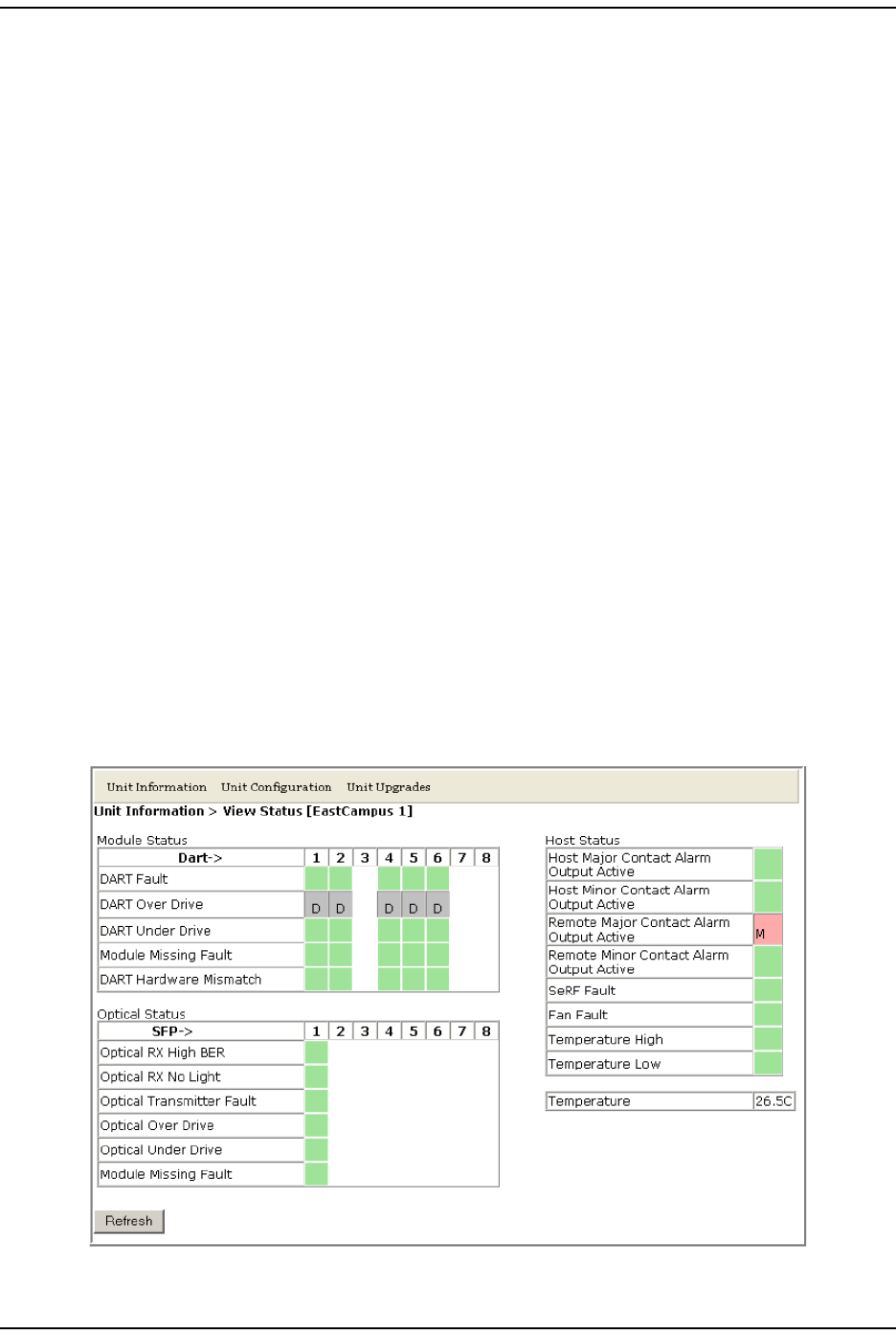
How t o Use t he EMS Graphical User I nt erface
Page 44 FlexWave Prism Elem ent Managem ent Syst em 7.1 User Manual
© 2011 ADC Telecommunications, Inc ADCP-77-177 • I ssue 1 • July 2011
Viewing Parameters and Alarms
You can view any param eter or alarm by navigat ing t o t he page in which t he
param eter or alarm resides. To quickly find inform ation about a param et er or
alarm :
•All param et ers are list ed alphabetically in this m anual’s I ndex.
•All alarm s are listed alphabetically in t his m anual’s I ndex of Alarm s.
•All traps are list ed alphabetically in this m anual’s I ndex of Traps.
Alarm Color Codes
Alarm s are color coded in t he GUI according to the level of the alarm :
•Green—No alarm
•Blue—I nform at ion alarm , which provides inform at ion on a successful user
act ion, such as a change in a forward or reverse delay setting
•Yellow—Minor alarm
•Red—Major alarm
•Gray—t he alarm has been disabled; see “Enable and Disable Host and Rem ote
Unit Alarm s” on page 178
•White—a device has not been inst alled. For exam ple, in Figure 18, which shows
the Unit Information > View Status page, t he Module Status table shows that a DART
has not been inst alled in slot s 3, 7, or 8. The Optical Status table shows t hat SFPs
are not inst alled in Opt ical ports 2 through 8.
Figure 18. Understanding Color Codes for Empty Slots